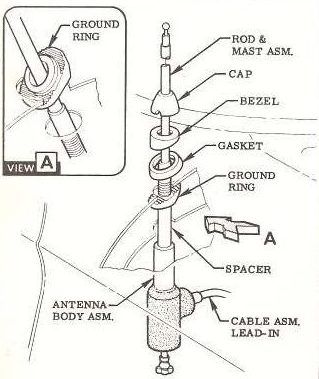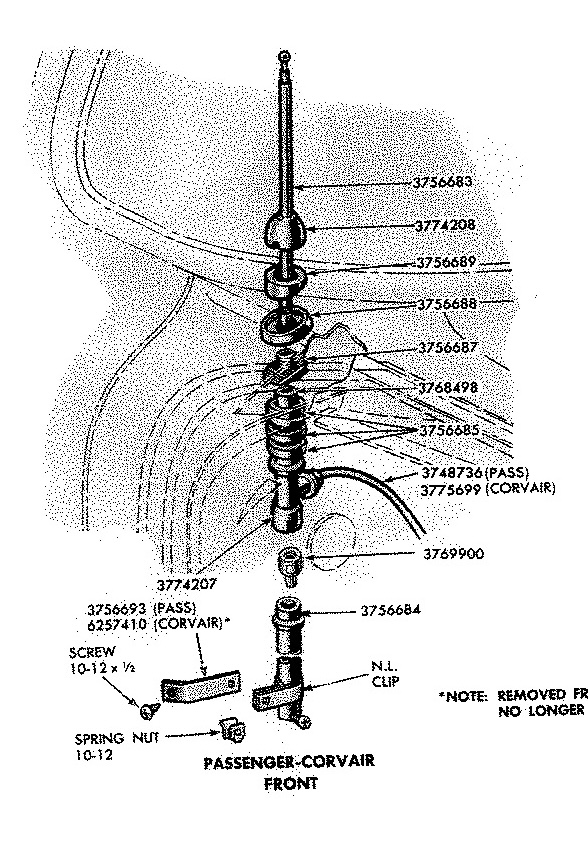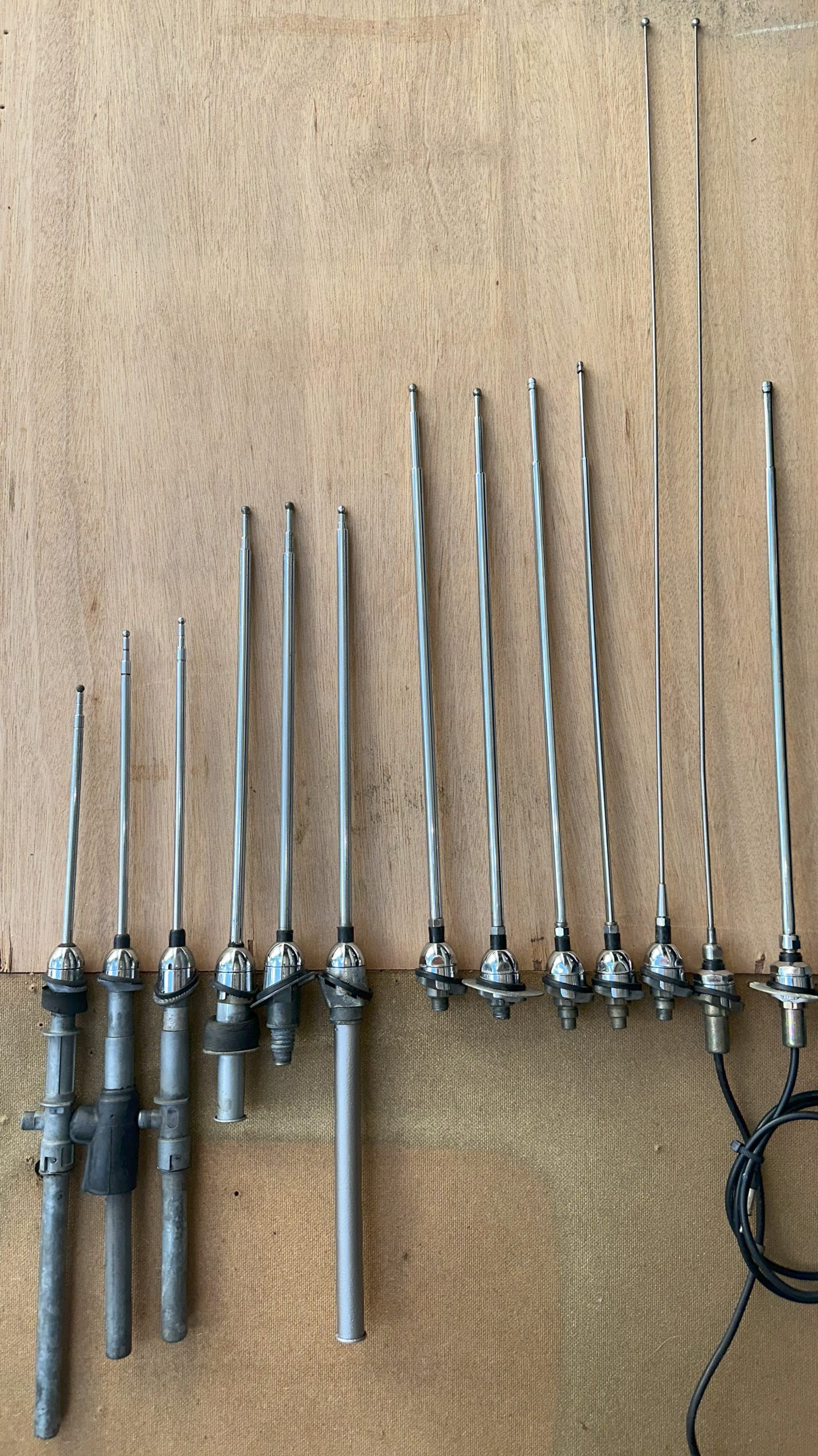In this article I will explore everything I’ve learned about Corvair radio antennas. As with all research projects, this article is subject to revision as new information becomes available.
Corvair radio antennas can be roughly divided into four major groupings, based on antenna mast and body styles. These groups are: 1960-62, 1963-64, 1965-69, and the 1966 Power rear antenna. Within these major groups there are, of course, several minor variations, which shall be described below.
Note: you can click on any of the photos or charts in this article to view them at full resolution. Use your browser’s “back” button to return to the article after viewing the photo.
Definition of Terms
The following list defines the names used by GM for the most common antenna parts from top to bottom, with diagram on the right for reference:
- Mast – the antenna rod
- Cap – the chrome nut that secures the antenna body to car
- Bezel – the chrome piece under the cap that that conforms to the body curve.
- Bezel Gasket – plastic gasket under the bezel
- Ground Ring – piece that clamps underside the body
- Spacer – tube that takes up space between antenna body & ground ring
- Antenna Body – all other parts attach to the antenna body
- Cable – attaches antenna to radio
- Stop – attaches to bottom of 1960-62 masts
- Tube – attaches to bottom of Body (1960-62 & front 1963-64)
About Antenna Unit Part Numbers…
Corvair radios and antennas were optional equipment. They could be ordered either as factory options (FOA/RPO) or as Dealer Accessories. Factory options usually have a 7 digit part number, whereas Dealer accessory kits usually have a 6 digit part number. We would therefore expect to find the same for Corvair antenna kits, but it turns out to be a bit more complicated than that.
Factory options were generally installed by the workers on the Chevrolet Assembly lines, but some parts were left for the dealer to install. In the latter case, these parts were typically detailed on a listing in the Assembly Manuals called the “Miscellaneous Shipping List“, or MSL. The MSL indicates the part number, part name, applicable models or options using the part, source of the part, location where the part is placed for shipping, and any other useful notes.
However, regardless of how ordered (option or accessory), radio antennas were (always?) installed by the dealer, to avoid damage in shipping.
1960-63 car and 1961-65 FC Assembly Manuals do not include antenna installation instructions but they do show the antenna listed on the MSL. The part number shown on the 1960-63 car and 1961-65 FC MSL is the complete antenna unit (mast, cap, bezel, gasket, seal, ground ring, spacer, antenna body, tube, clamp, wire, etc. plus installation instructions) because the dealer was responsible for installing the entire assembly, including the act of drilling the hole in the fender. Since there was only ever one antenna option for 1960-63 car or 1961-65 FC, we can be pretty comfortable assuming those part numbers shown in the MSL are the official GM part number for those complete antenna units. However, it is curious that a search on any of those listed numbers returns no results, aside from the Assembly manual entries.
The 1964 Car Assembly manual is an oddity. Given that there were two possible antennas for cars (front and rear), you would expect two different numbers on the MSL. However, the 1964 car Assembly Manual has NO antenna listing on the MSL but it DOES include antenna installation instructions for both front and rear antennas. I don’t know if this means the 1964 radio antenna was actually installed at the factory or not. It seems unlikely that they would have installed it at the factory and risked damage in shipping to dealers, but without further documentation we are left guessing. (The 1964 FC assembly manual does list the antenna in the MSL.)
From 1965-69, all antenna wires and bases were installed at the factory; only the mast was shipped for the dealer to install. Therefore the MSL antenna entry is just the part number for an antenna mast. However, there is only ever ONE number listed, even though there were generally TWO possible masts that could be used (AM or FM), so this is confusing.
For 1965, the MSL started off listing the telescopic (AM) mast number (3863099), but switched to the 31″ fixed (FM) mast number (3875700) on 12-7-64. It’s likely that this change reflects a realization that the fixed length mast provided better FM reception, but it introduces confusion as to what masts were used for the AM radios after this point. 1966 continued to show the fixed antenna mast as the single listing in the MSL, but from 1967-69 the MSL entry is the part number for the telescopic mast – more confusion.
Photos below show MSLs for a few different years.
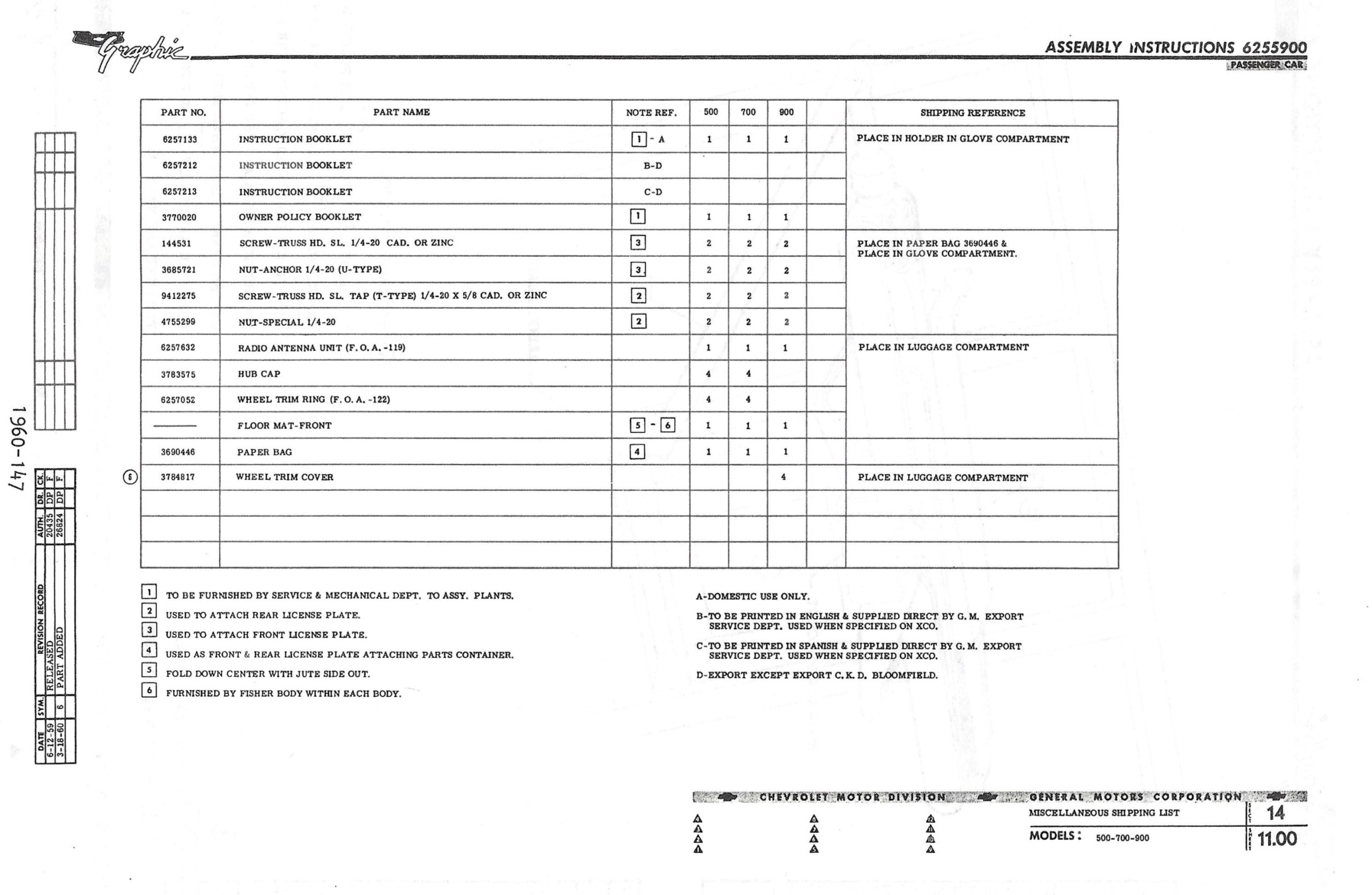
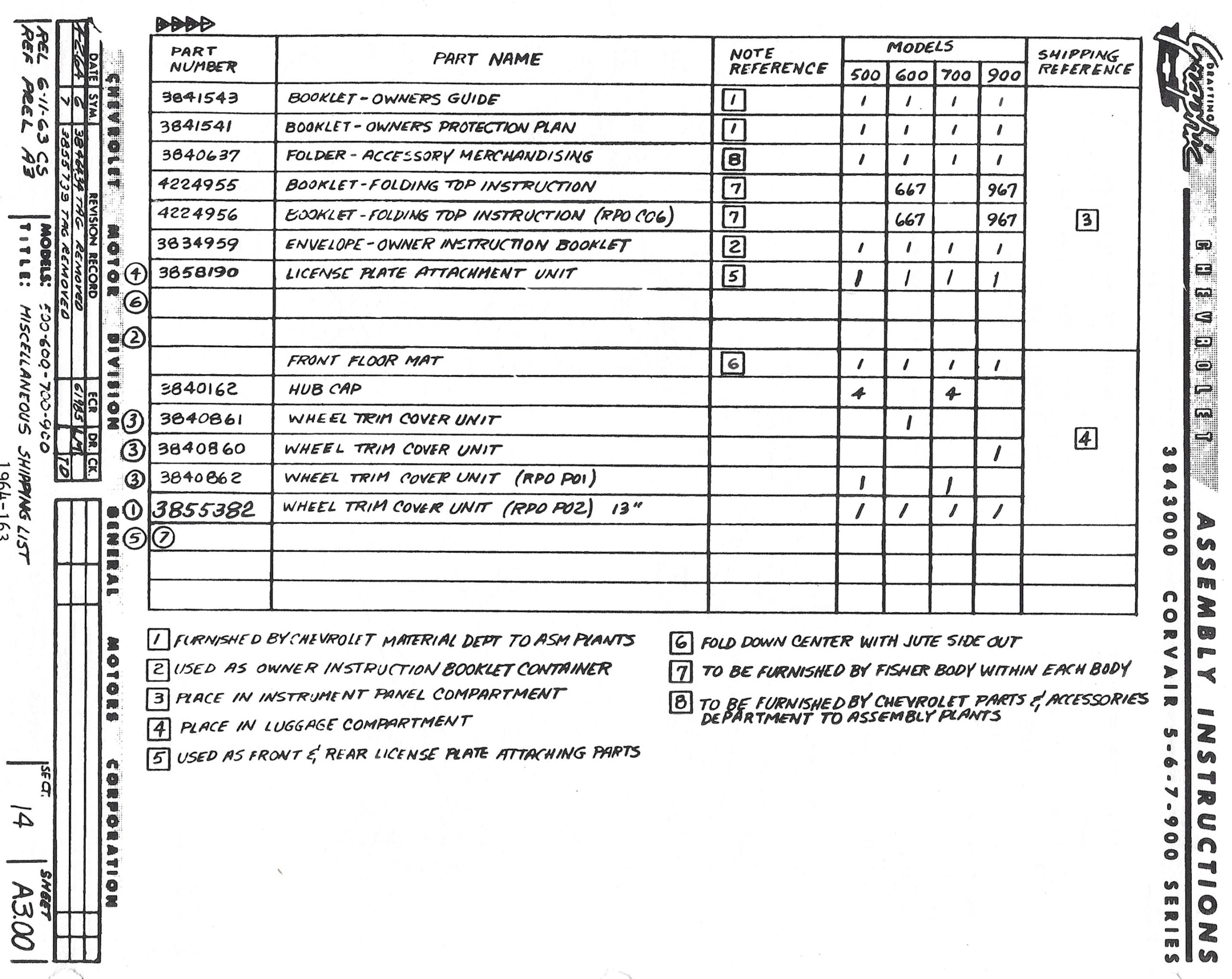
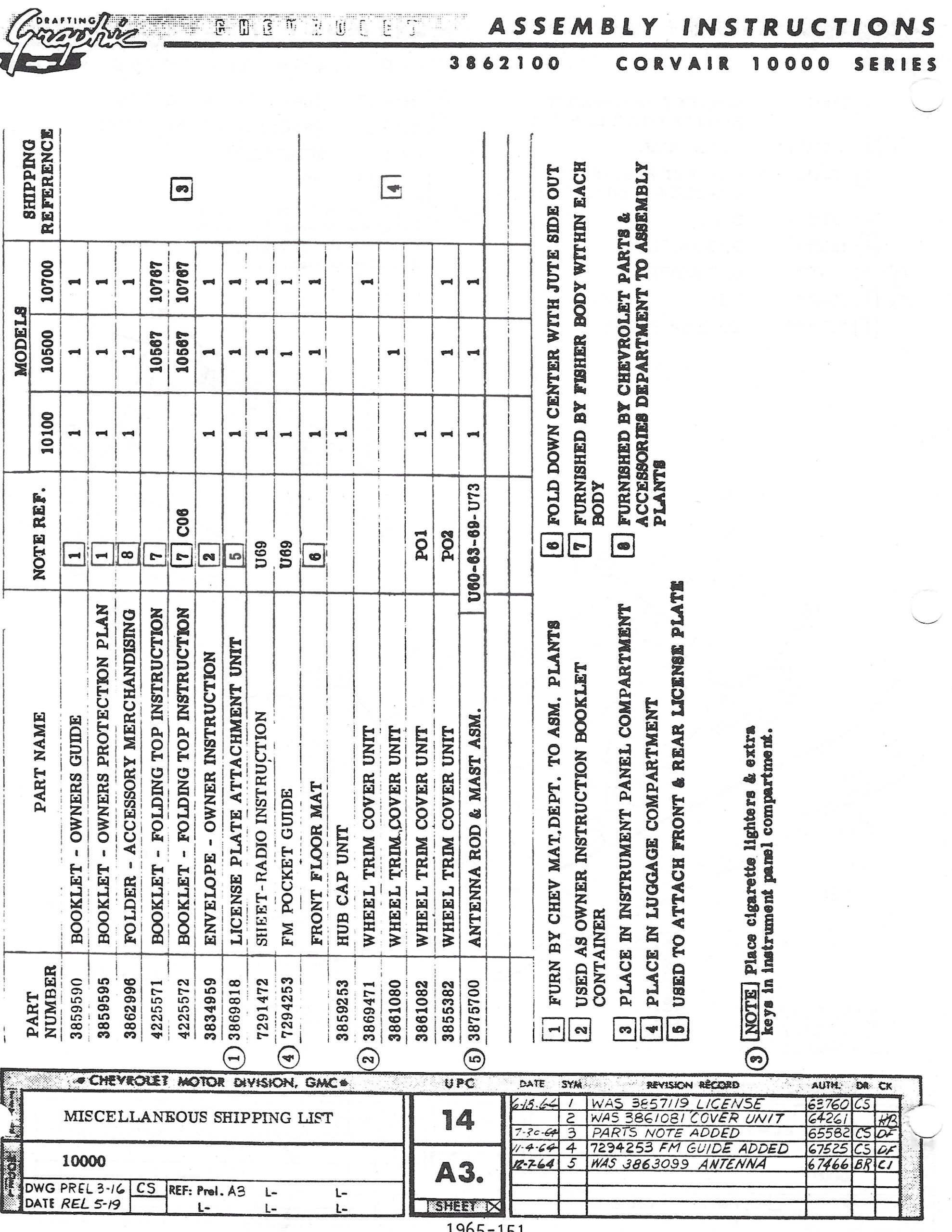
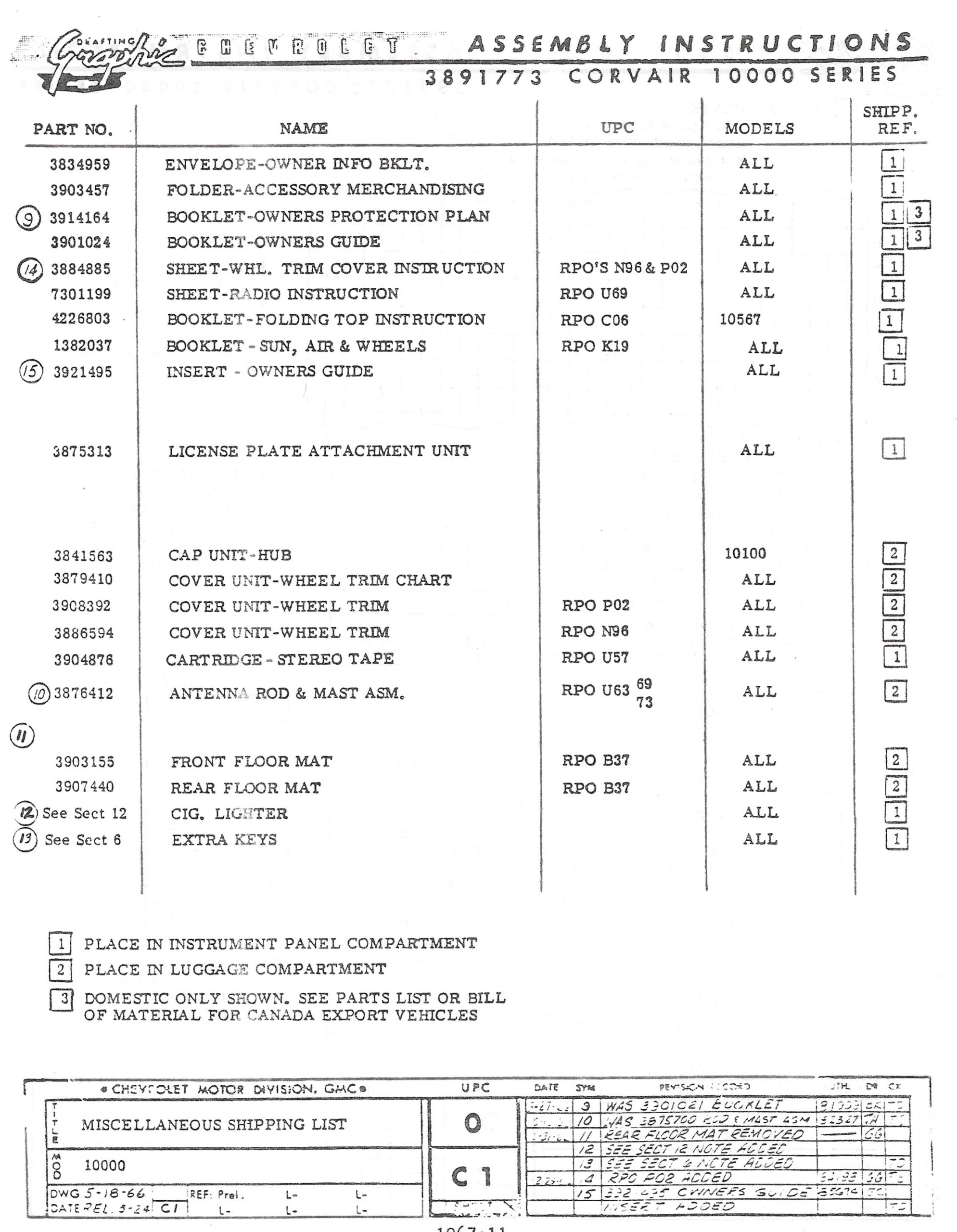
As stated previously, typical GM part numbers are 7 digits long, so you would expect to find 7 digit numbers for each year’s antenna unit. However, when looking up Corvair antenna units in Parts & Accessories (P&A) books, you only find the 6 digit numbers for the accessory antenna units, not the 7 digit MSL part numbers. Also, as mentioned above, all antennas (except perhaps 1964 car?) were dealer installed, and all of the dealer antenna installation instructions are printed with the 6 digit accessory numbers.
Therefore, to avoid confusion, I use the 6 digit Accessory part number for the entire antenna unit in the individual antenna sections below. I’ve added a chart at the end of this article which shows both 7 digit MSL and 6 digit Accessory numbers for each antenna, where available.
Group 1: 1960-62
There are three antennas in this group: 1960, 1961-62 car, and 1961-62 FC; all used the same antenna mast, cap, body, and stop. A unique feature of this group is the ability to partially retract the antenna mast into the body of the car.
The antenna body (3774207) is cast aluminum, 6 1/4″ tall. The mast slides inside of this body. The upper end of the body incorporates a plastic seal while the lower end provides a socket into which an extension tube is attached to allow further retraction of the mast. The antenna wire attaches to the side of the antenna body by means of a threaded port.
The antenna stop (3769900) is a plastic piece that snaps onto the bottom of the antenna mast to prevent the mast from being pulled or pushed out of the body and lower tube.
The antenna mast (3756683) is a round, bright chrome, 3 section telescopic shaft, 57″ extended, 21.5″ collapsed length. However, the installed length (above the cap) will be approximately 51″ extended because 6″ of mast remains in the antenna body. The collapsed length will depend on the length of the tube attached to the lower end of the antenna body. The mast has a special knob on its lower end to allow installation of the plastic stop.
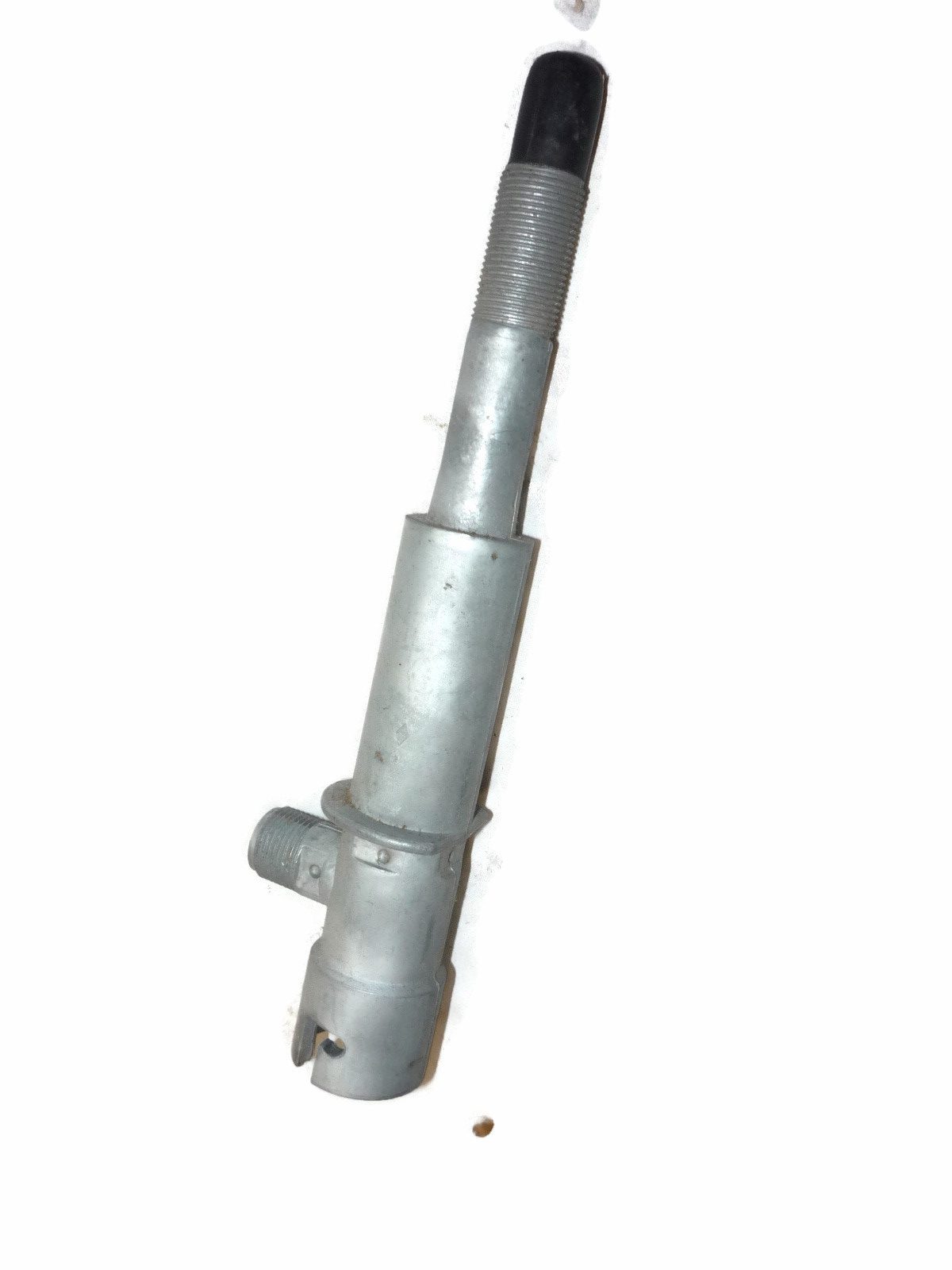
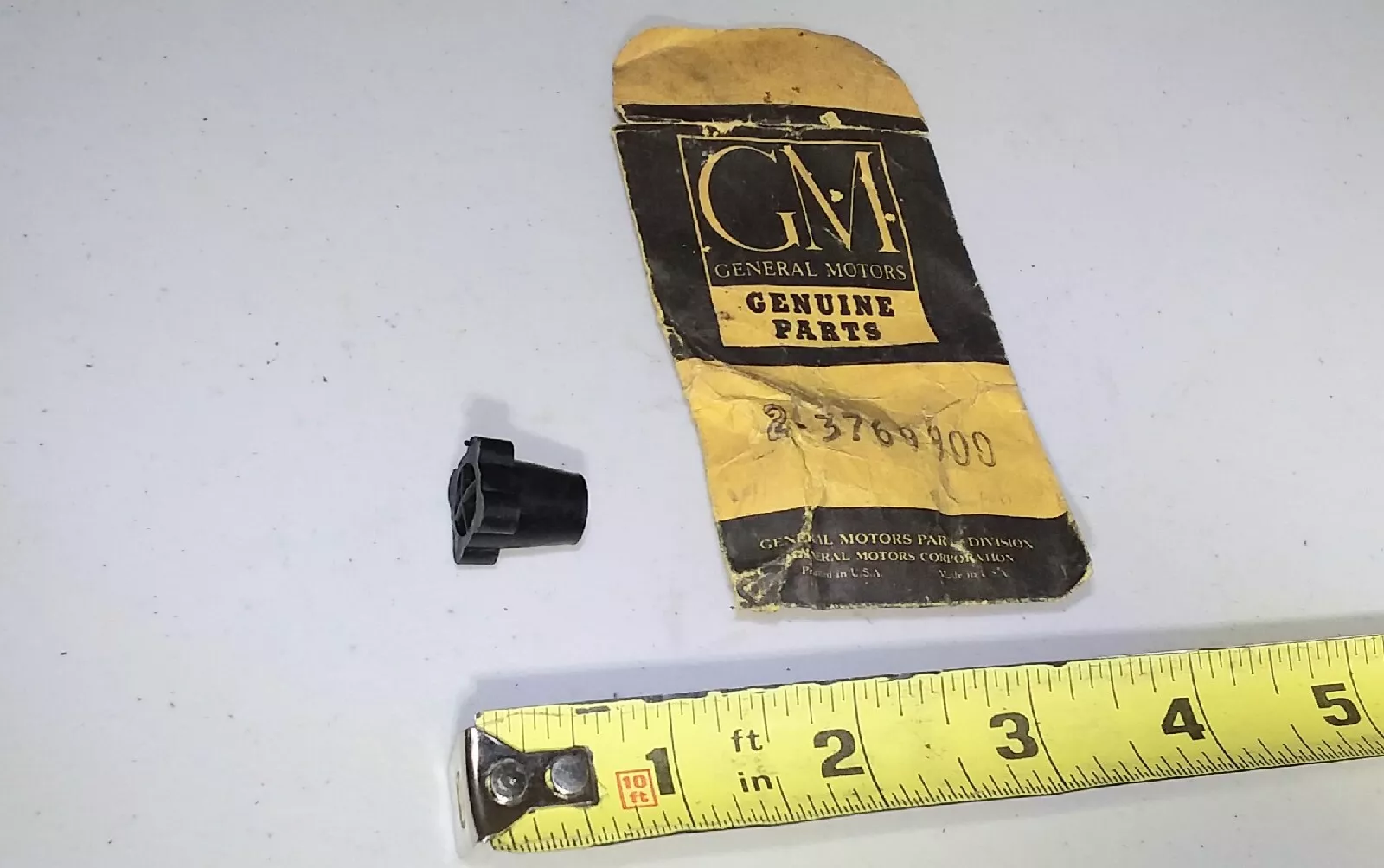
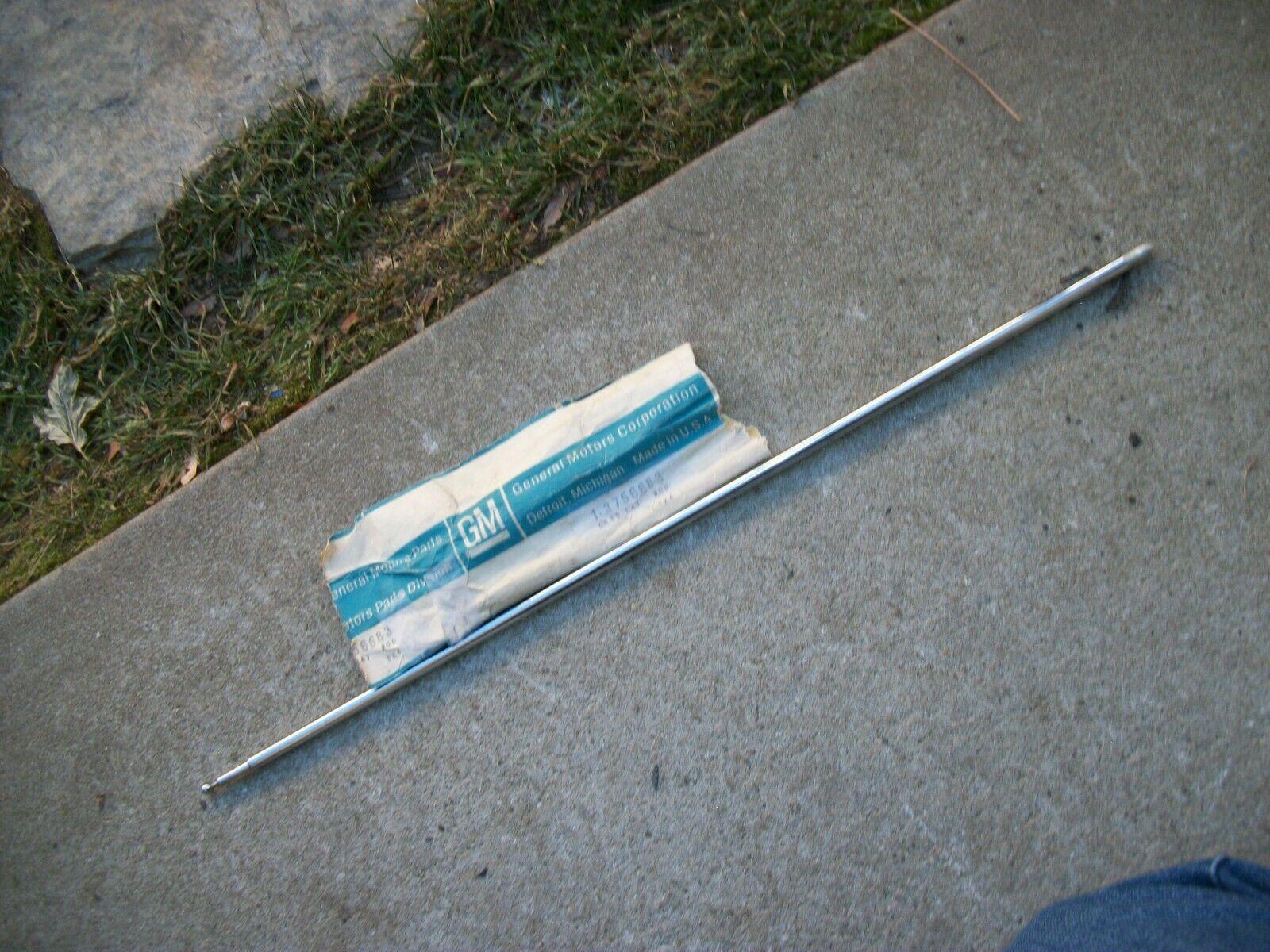
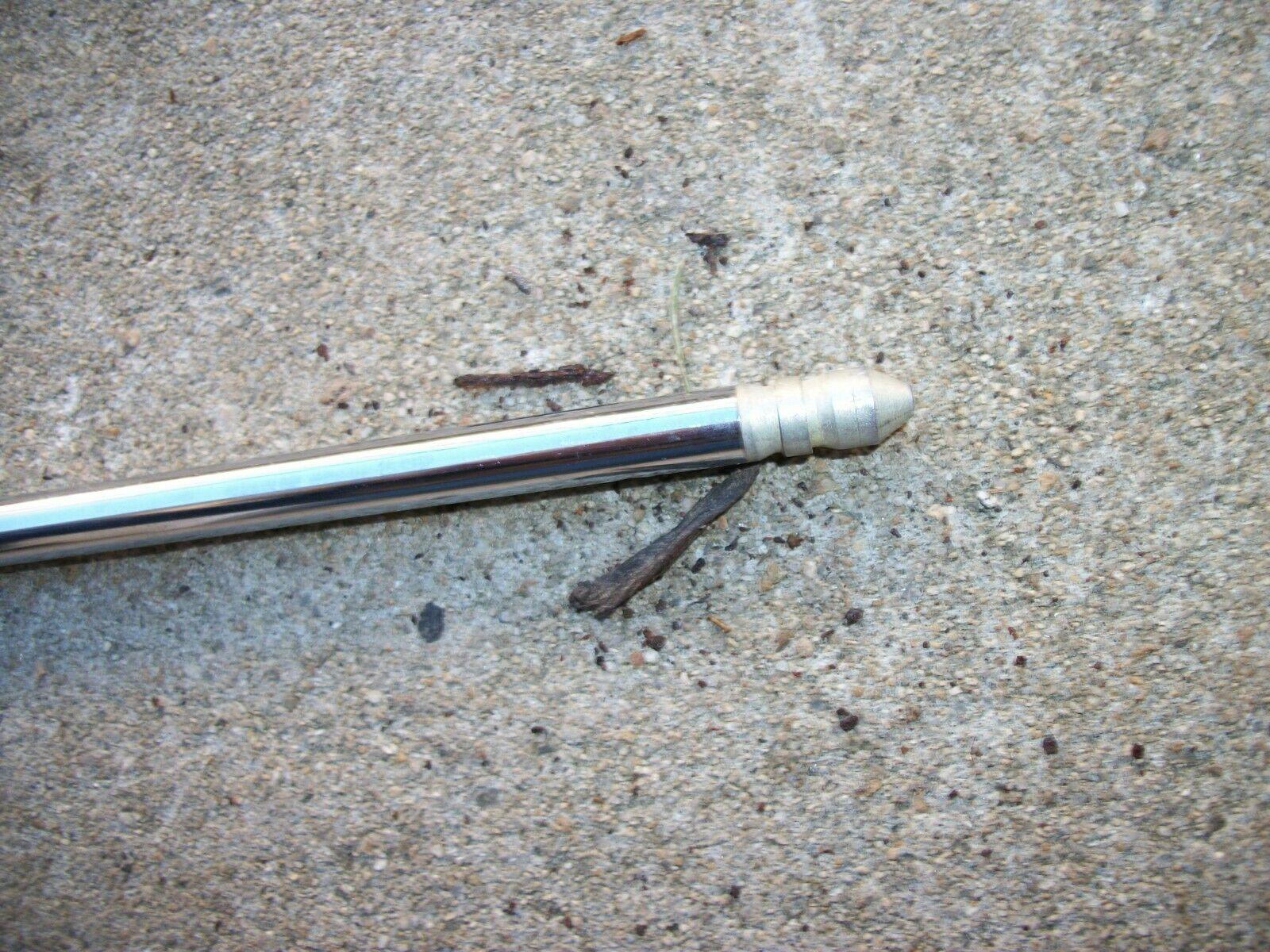
1960 Antenna (988063)
This was used on 1960 cars with AM radios. It was installed in the right door hinge pillar. It includes a foam rubber seal below the ground ring and a clip and strap to secure the bottom of the tube to the car. This uses a lower tube about 7 1/4″ long, so the antenna could be retracted to about 8″ above the top of the cap.
Click here to view the complete 1960 Antenna Installation Instructions
1961-62 Antenna (985055)
This was used on 1961-62 cars with AM radios. It was installed in the right cowl vent channel. Because that location potentially exposed the antenna wire connection to water, a rubber boot was added. Additionally, the lower tube had to be shortened 2 1/2″ to accommodate the space, which meant that this antenna could only be retracted to about 10 1/2″ above the top of the cap.
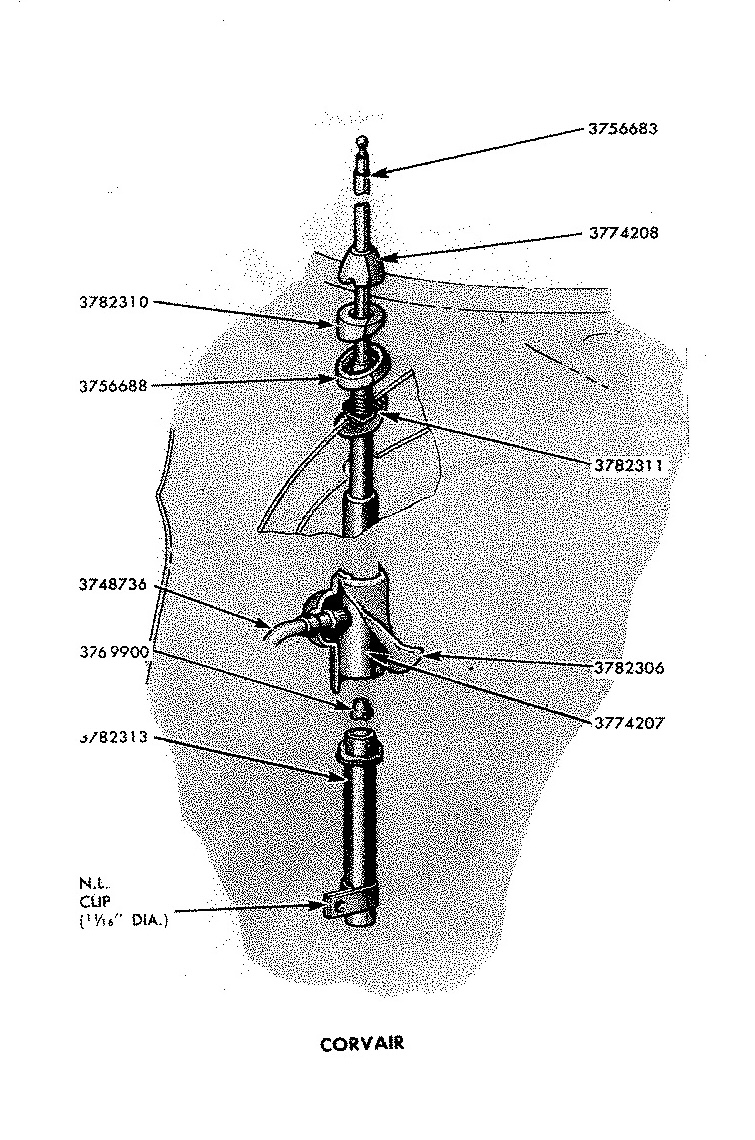
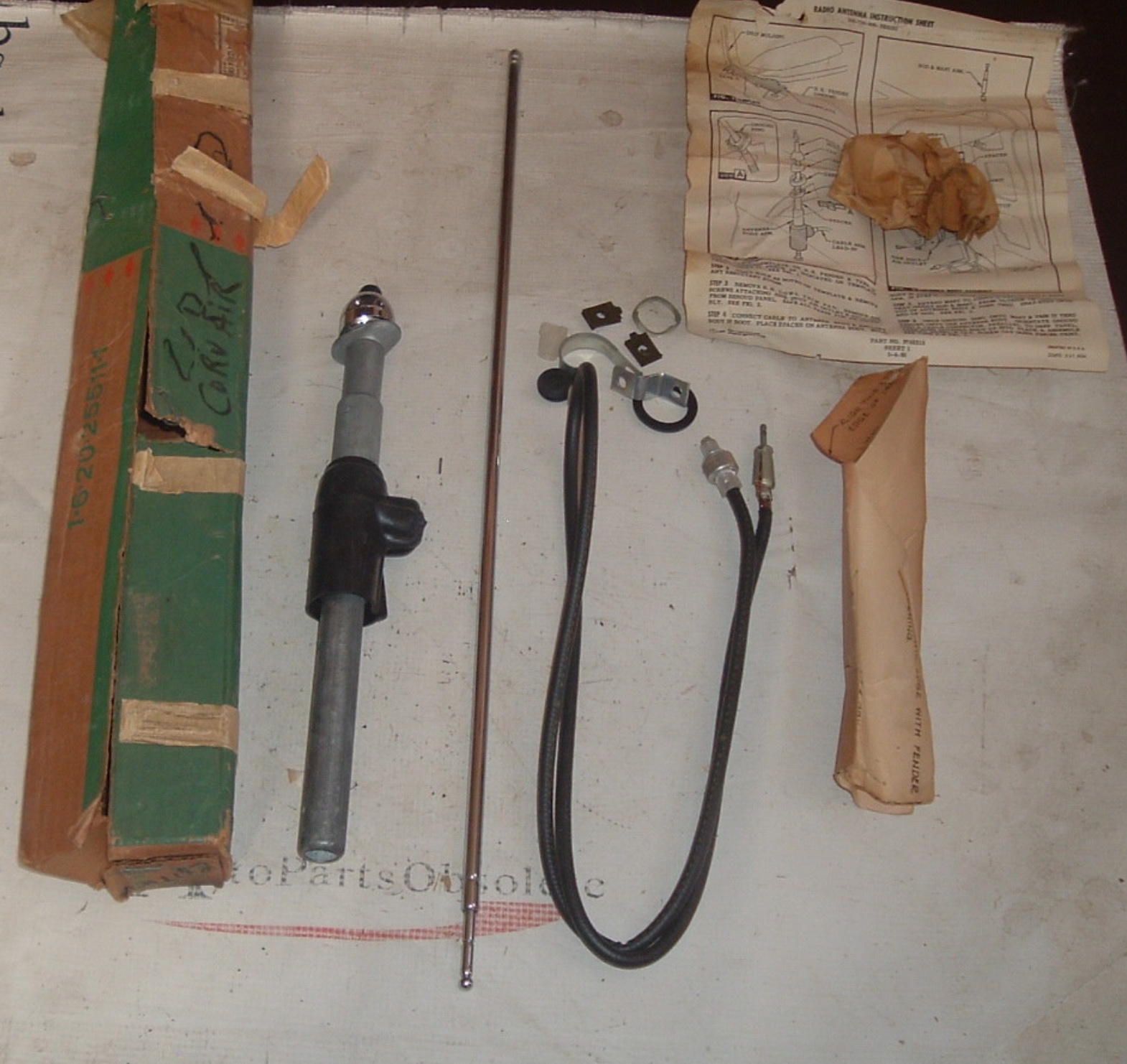
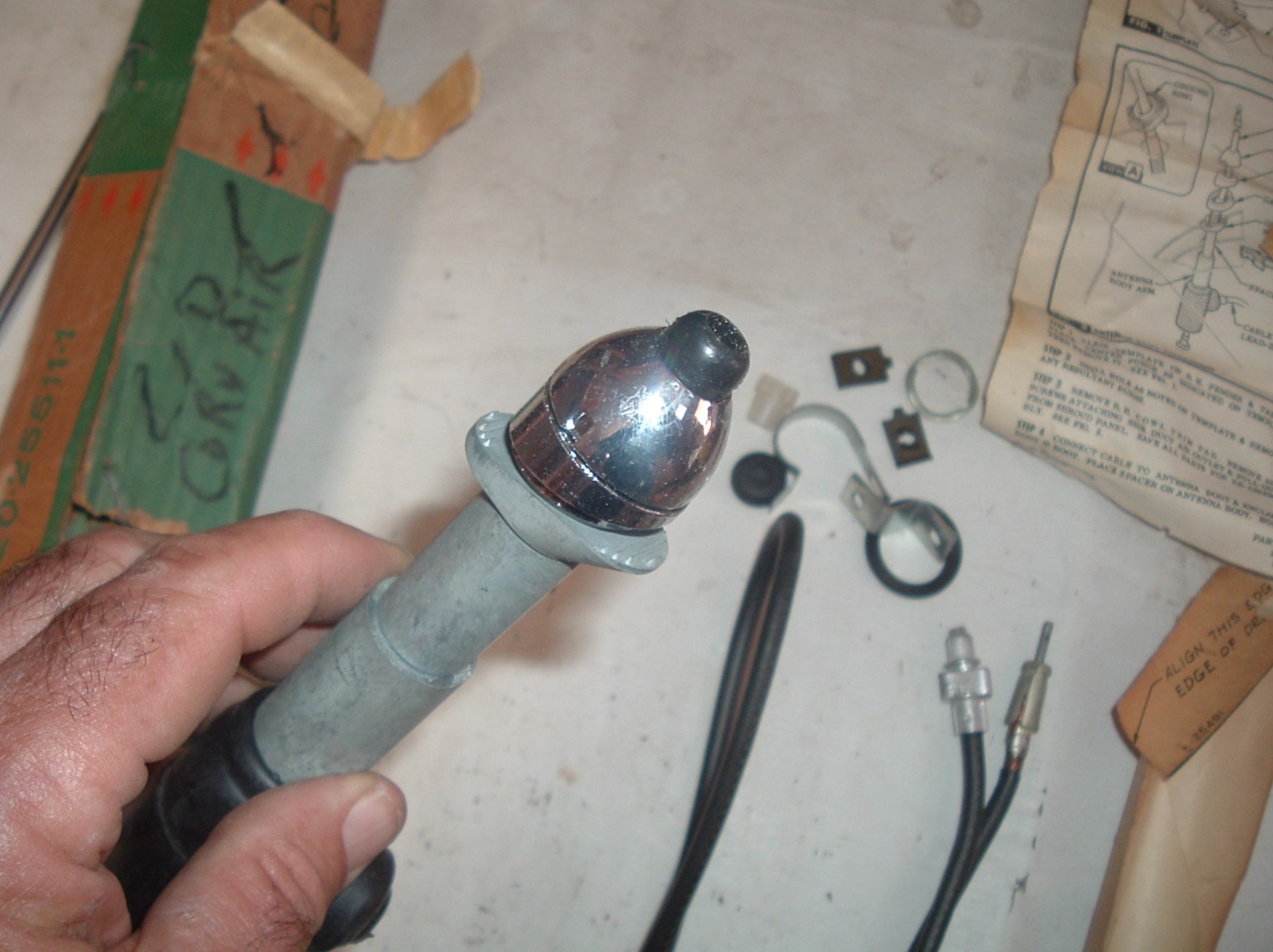
Click here to view the complete 1961 or 1962 Car Antenna Installation Instructions
1961-62 FC Antenna (988329)
This was used on 1961-62 Forward Control vehicles with AM radios. It was installed in the right front corner, requiring removal of the right headlight unit to install. The lower tube was approximately the same length as the 1961-62 car, giving a collapsed height of about 10.5″ (although sales literature stated 12″). This antenna used neither seal nor boot.
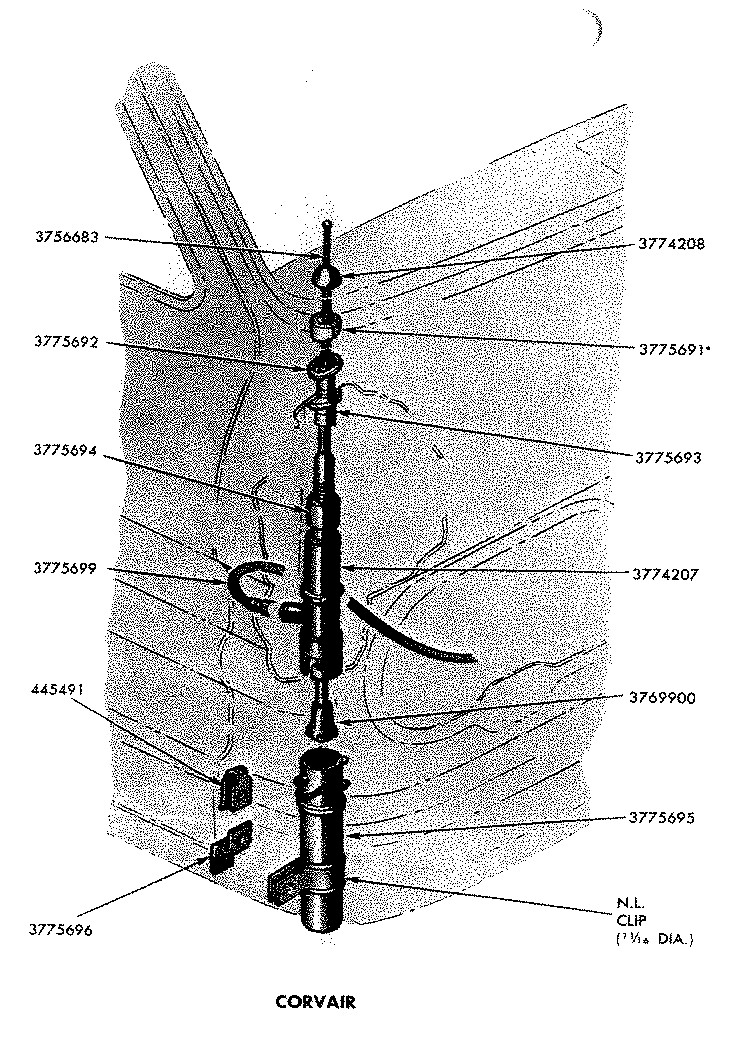
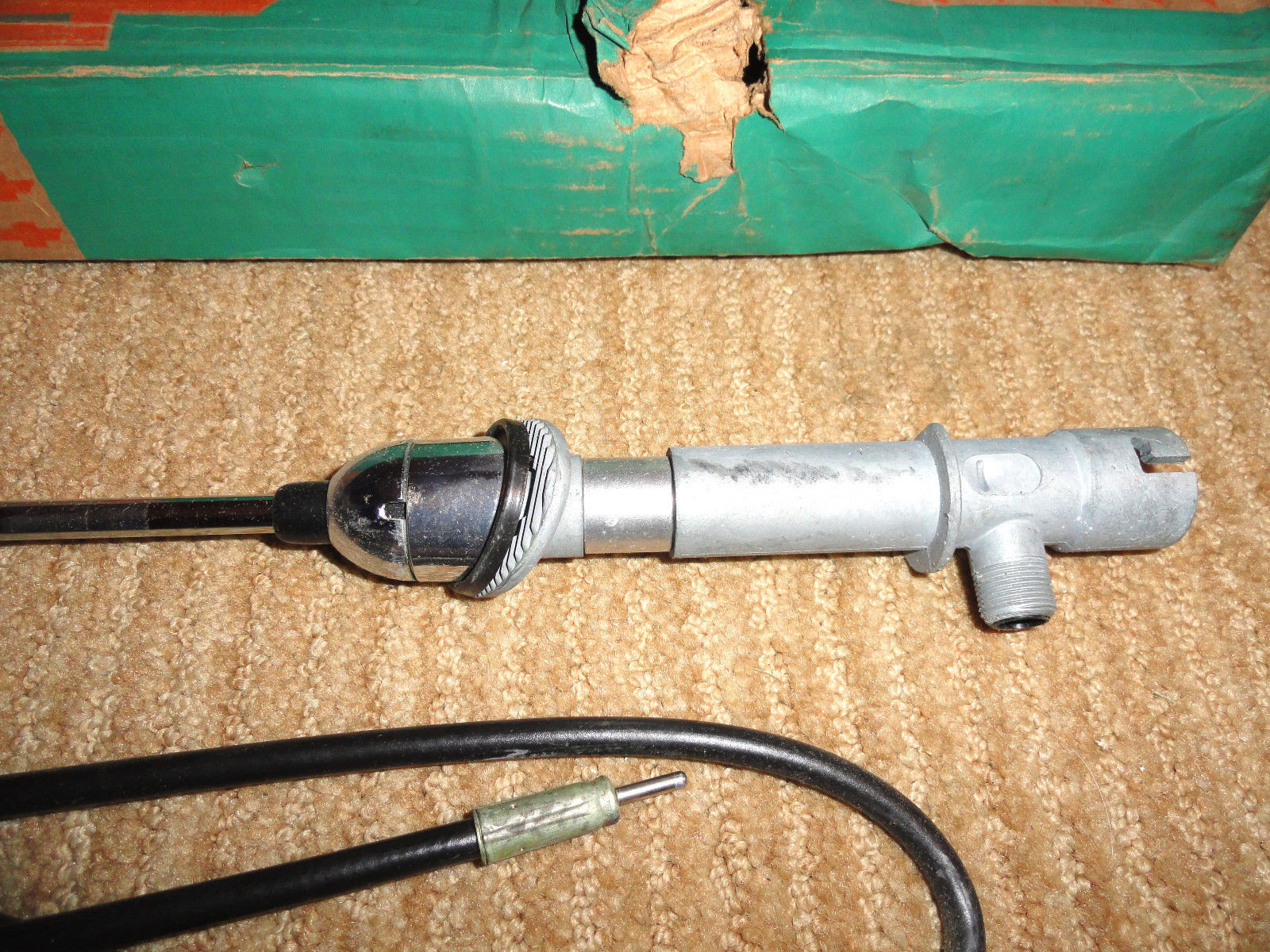
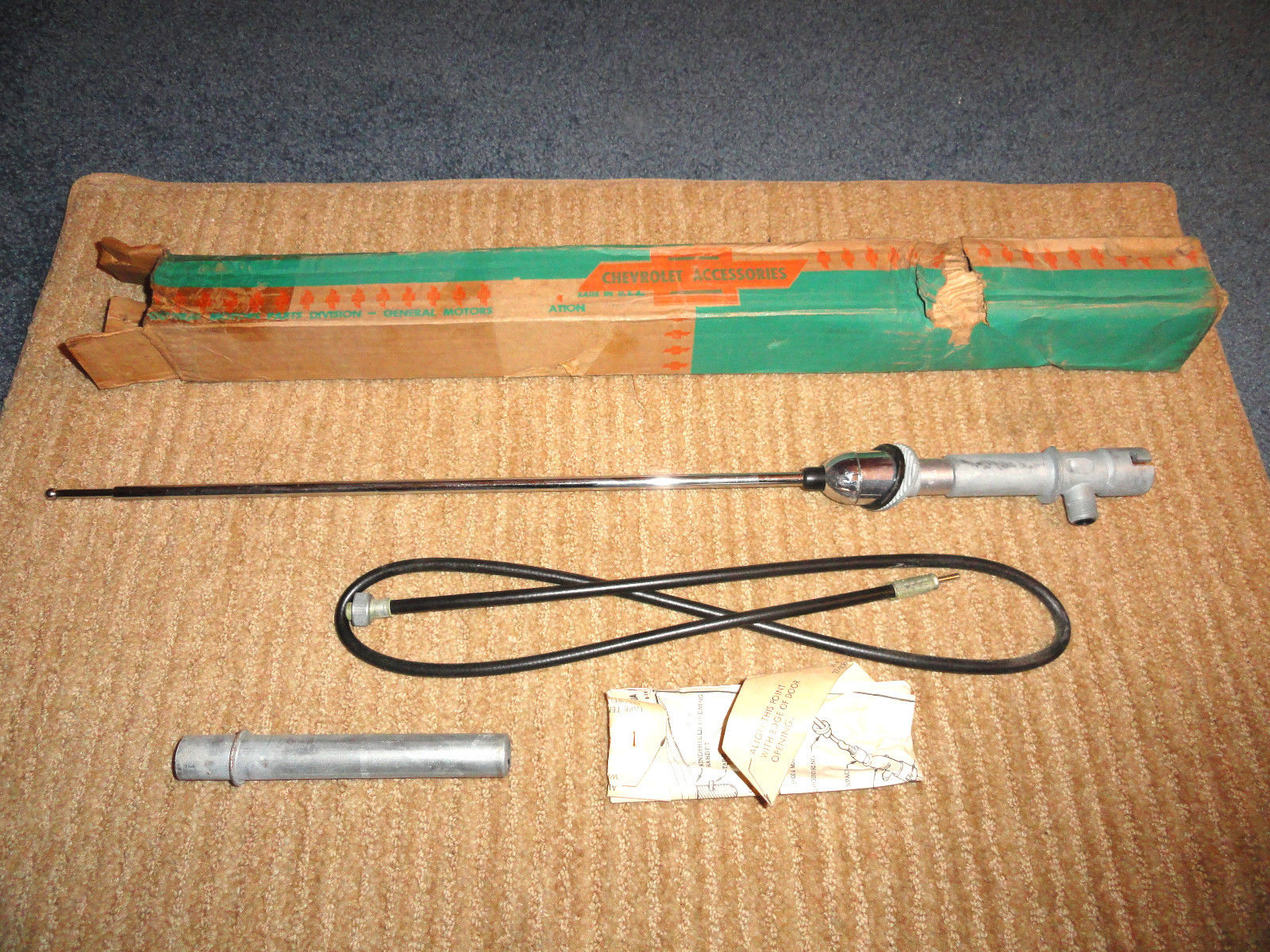
Click here to view the complete 1961 or 1962 FC Antenna Instructions
Problems with Group 1 Design
While it was a nice feature to allow the antenna mast to slide down into the antenna body, this also allowed a tiny amount of water to wick inside, eventually leading to corrosion, especially in winter climates. Therefore, this design was replaced with the Group 2 design beginning in 1963.
Group 2: 1963-64 car and 1963-65 FC
There are 4 antennas in this group: 1963-64 front car antenna, 1963-64 rear car antenna, 1963-65 FC antenna, and 1964 left rear dummy antenna.
Antenna mast/body (3820663) is used for all 1963-64 car and 1963-65 FC working antennas (1964 dummy used nonfunctional part # 3843918) The mast is permanently mounted to the body and cannot be removed or serviced. It is a 4 piece telescoping round mast finished in bright chrome approximately 14″ retracted and 54″ extended (measured from top of bezel).
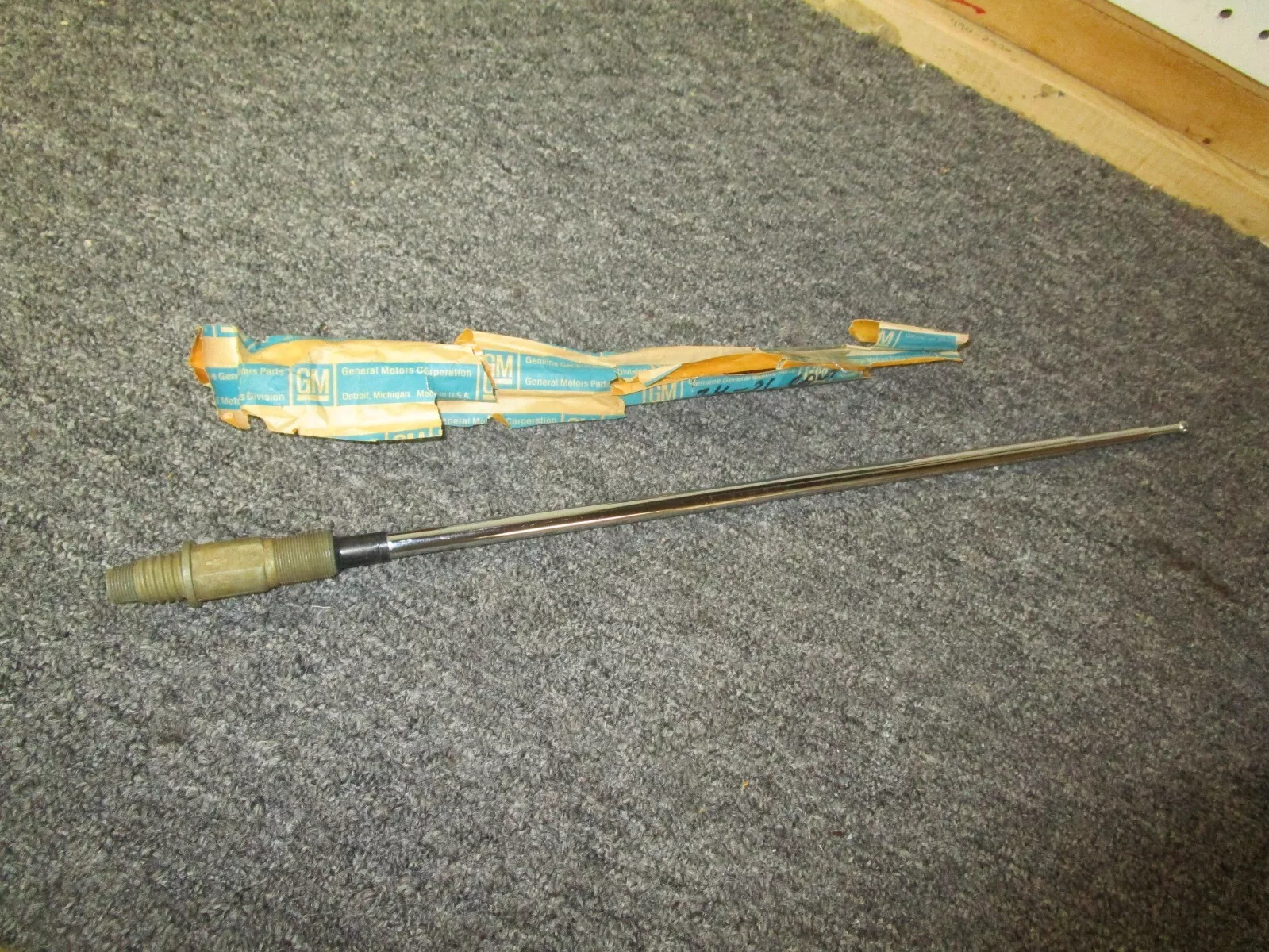
There seems to be some variability in the way the masts are constructed, some having indented rings at the top of each shaft, other having no such rings. There is also variability in the way the different segments line up when collapsed. It is not known whether these variations represent designed changes or just different manufacturing techniques. Most of the antennas seemed to have been manufactured by Ward, but it’s possible that other companies provided antennas as well. The most contemporaneous part number source I’ve found is the 1964 car Assembly manual which indicated part number 3820663 for both front and rear antennas. Unfortunately, neither the 1963 car nor 1963-1965 FC Assembly manuals list the part number for this item, so I have to rely on less contemporary parts manuals (Radio P&A 5B Feb 1967) which state the same number for all in this group. I recognize that it is possible, however, that 1963 car and 1963-1965 FC could have originally used a different part that was later replaced by the 1964 part, which might therefore account for the observed changes. Photos below show the difference among 4 antennas, all with Chevy bowtie symbol on the body.
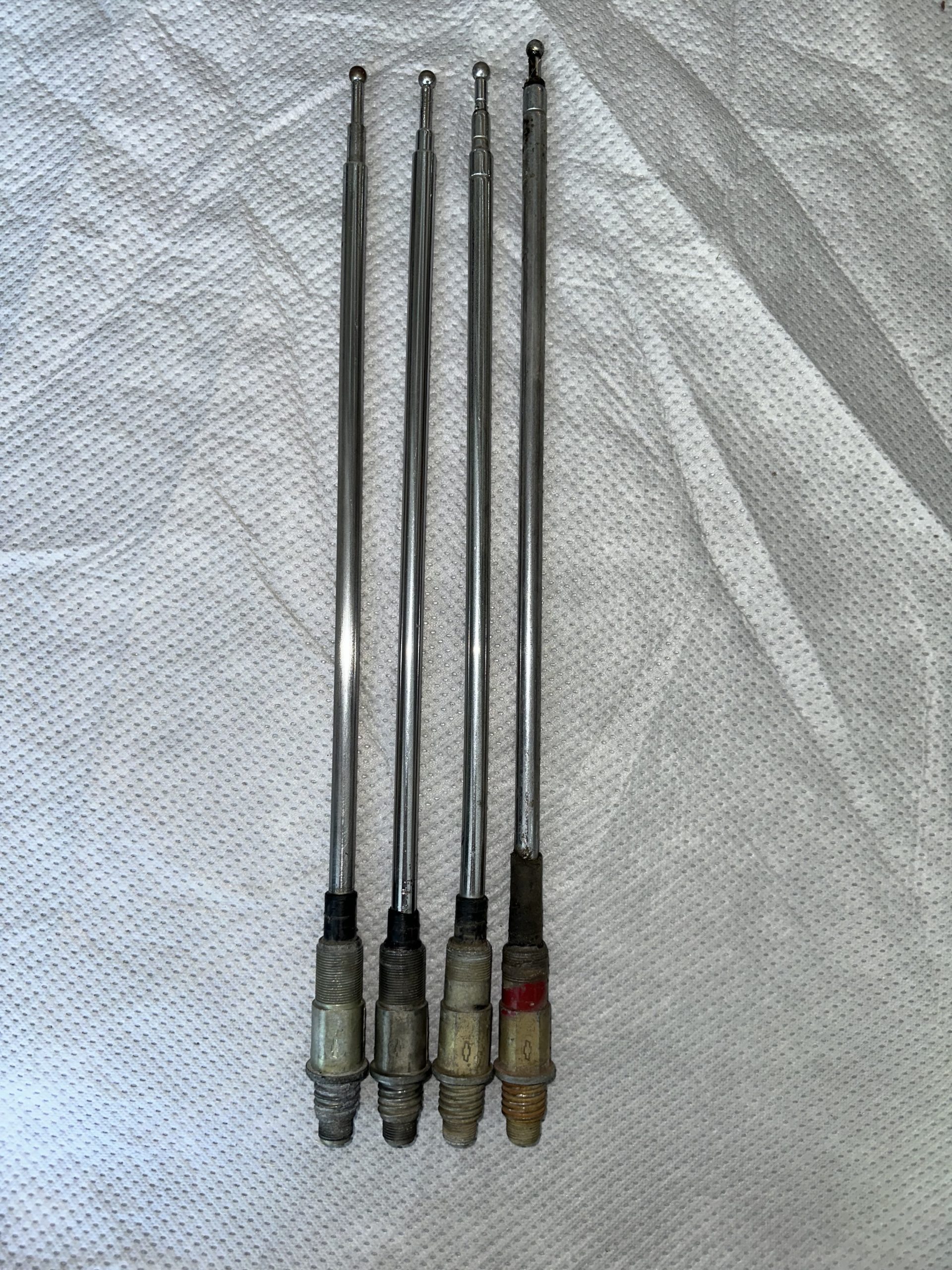
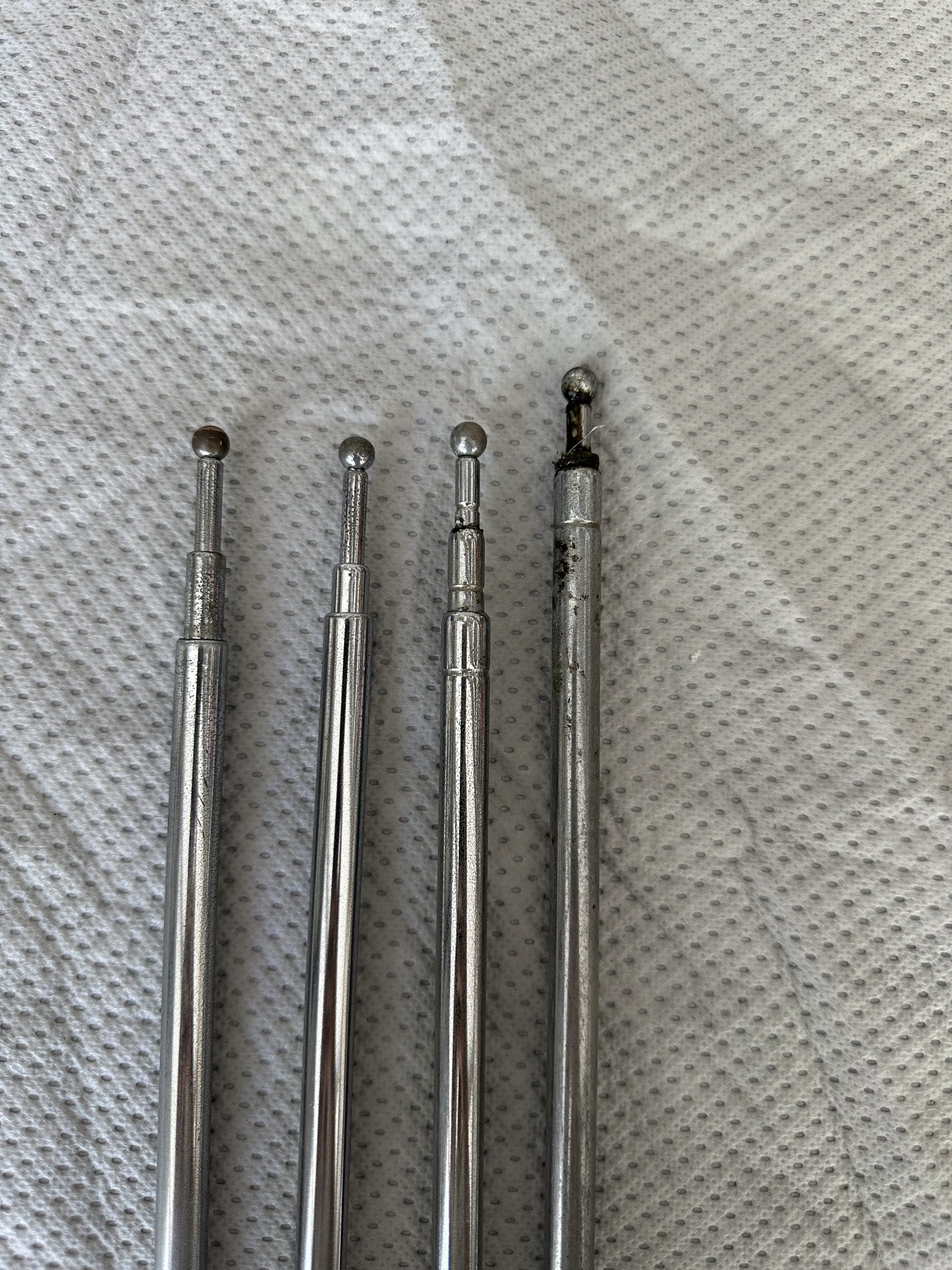
1963-64 Front Antenna (985450)
This antenna is used for 1963-64 cars with AM radios, front antenna. It is mounted in the right door hinge pillar, same as 1960. Like that antenna, it includes a foam rubber seal below the ground ring. It also includes a lower tube, but unlike the 1960-62 antennas, the antenna does not slide into this tube; it exists only to provide support, being attached to body with a clip and clamp.
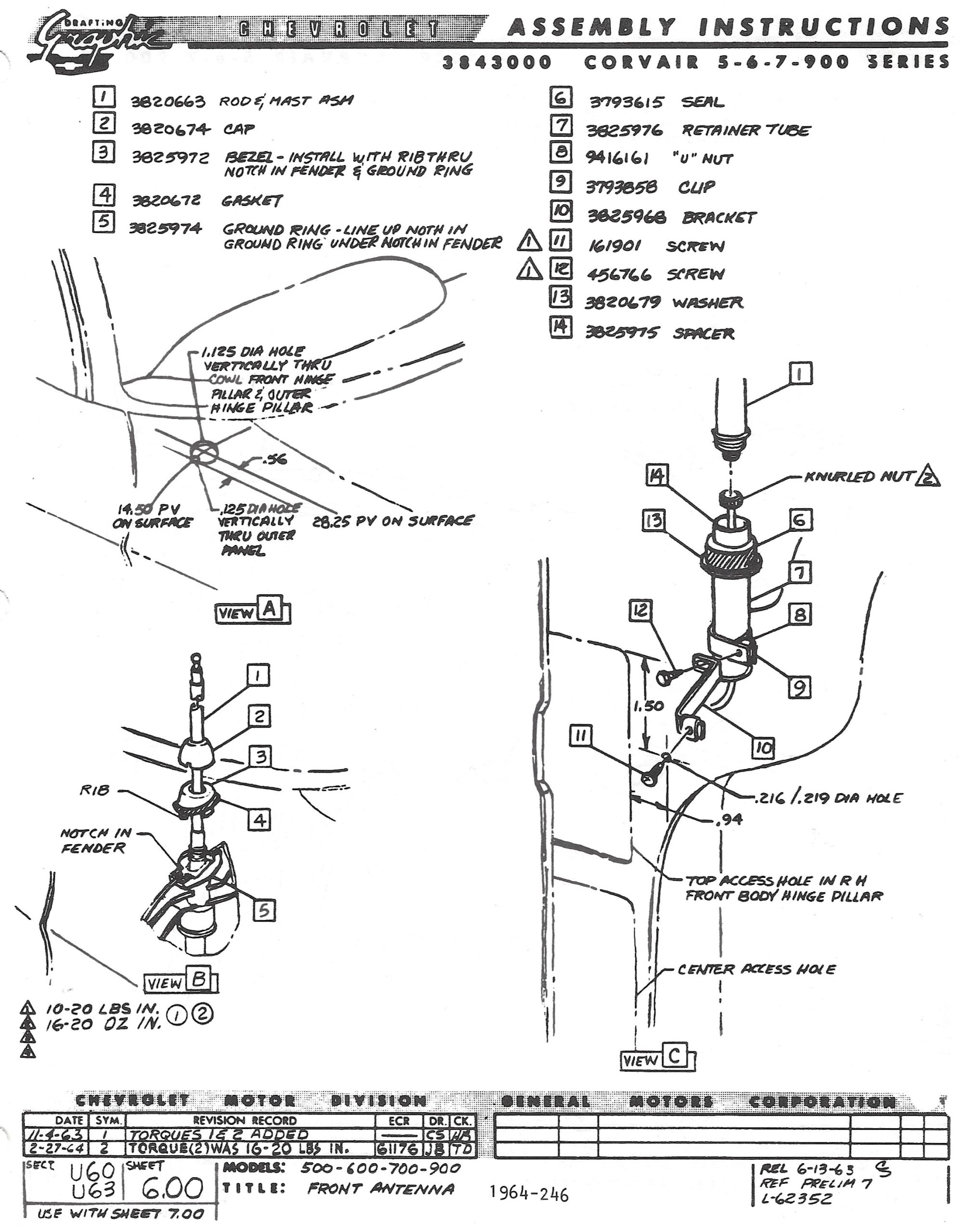
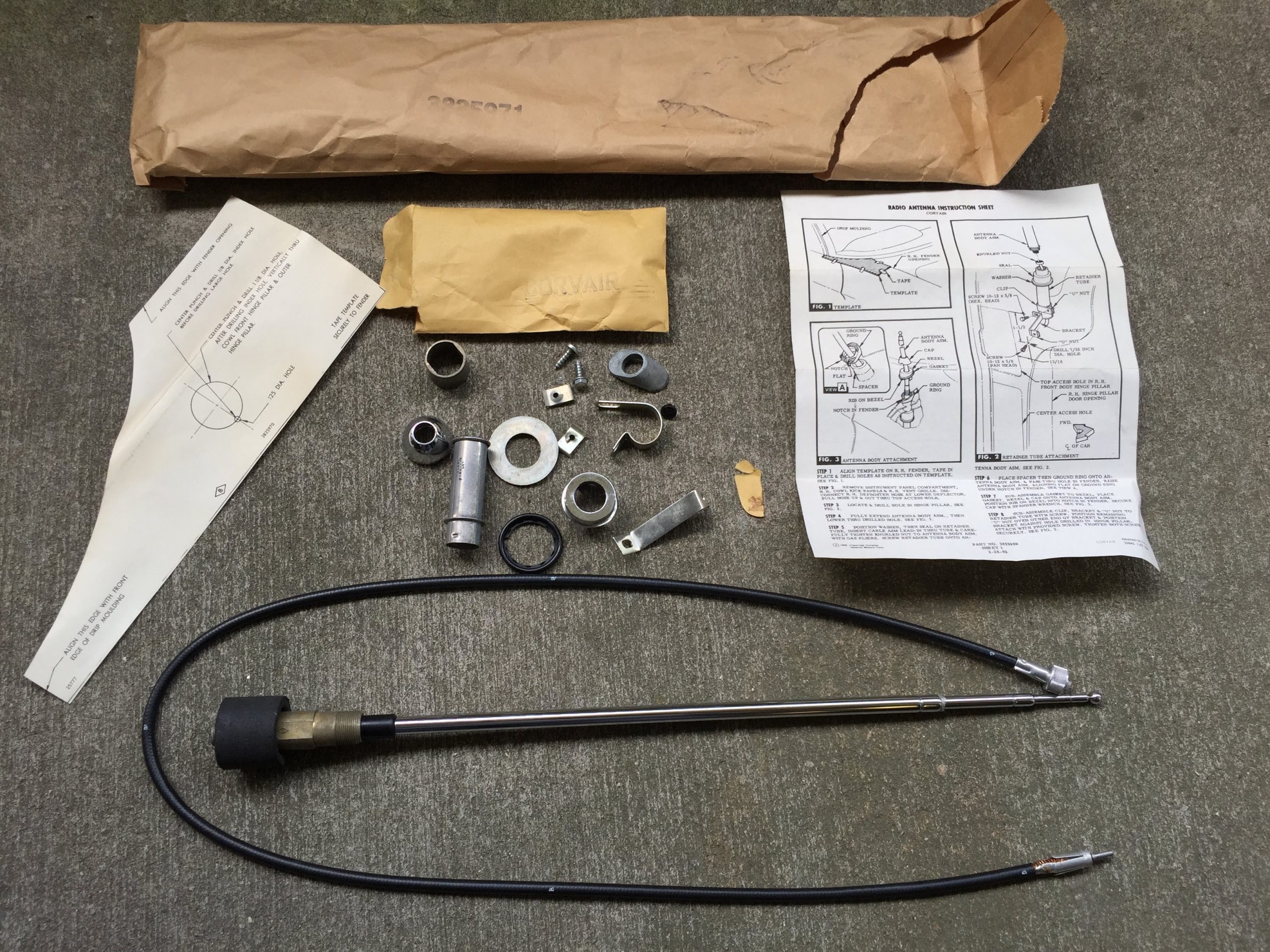
Click here to view the complete 1963 or 1964 Front Antenna Installation Instructions
1963-64 Rear Antenna (985763 [63] or 985940 [64]),
1963-64 Dummy Left Rear Antenna (985764 [63] or 985941 [64])
This antenna was the optional rear antenna for 1963 or 1964 cars with AM radio. It was mounted in the right rear quarter panel. Unlike the front and FC antennas, this one does not use a lower tube.
The 1963 versions were introduced late in the model year and are poorly documented. As near as I can determine, they are identical in all respects, despite the different part numbers for 1963.
Thie live right antenna uses a different ground ring , bezel, and bezel gasket to accommodate the different location and the raked back alignment. There are separate wiring schemes for each of the 3 body styles (coupe, sedan, convertible) as shown in the photos below.
The dealer-only 1963-64 Dummy antenna installed in the left rear quarter.
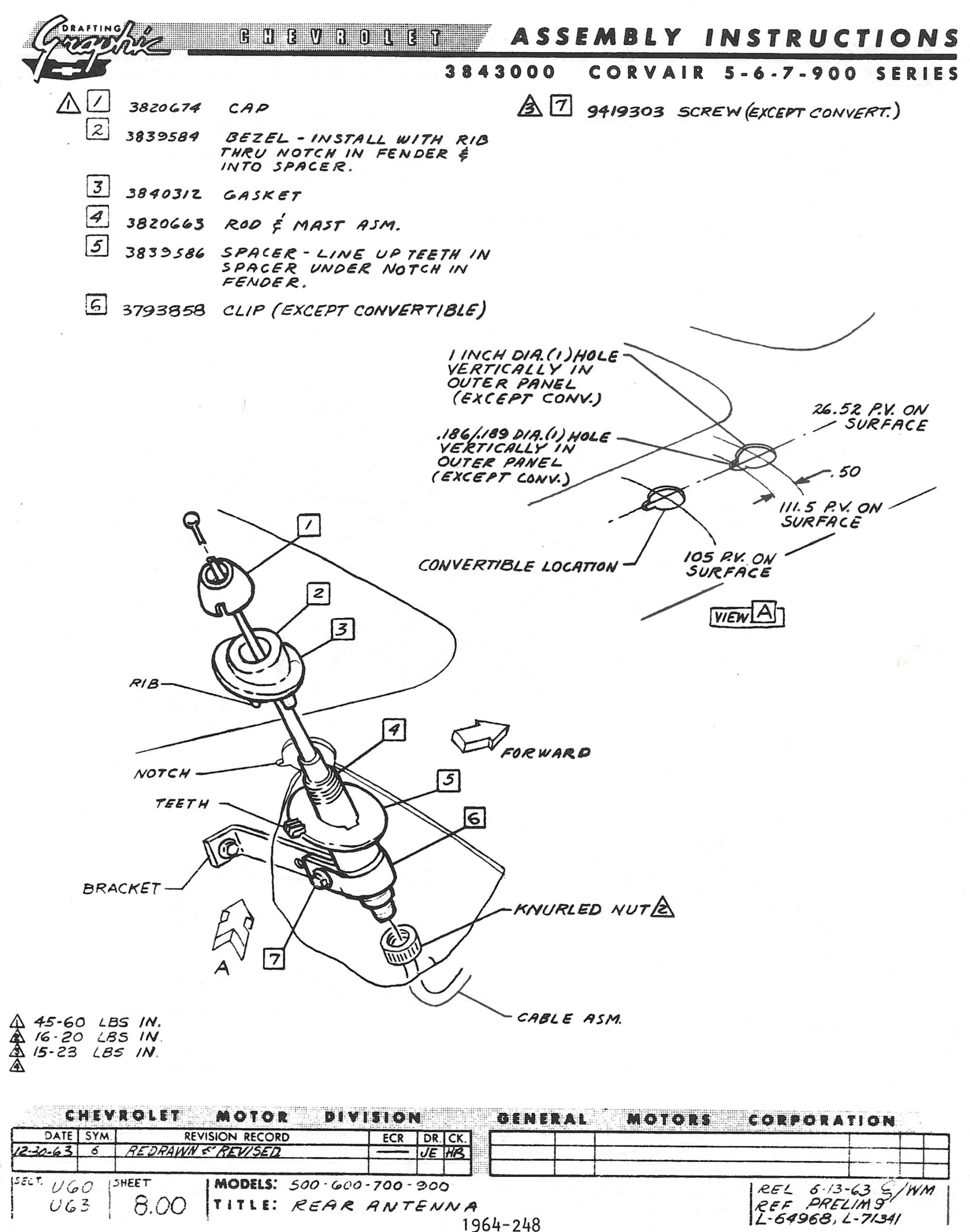
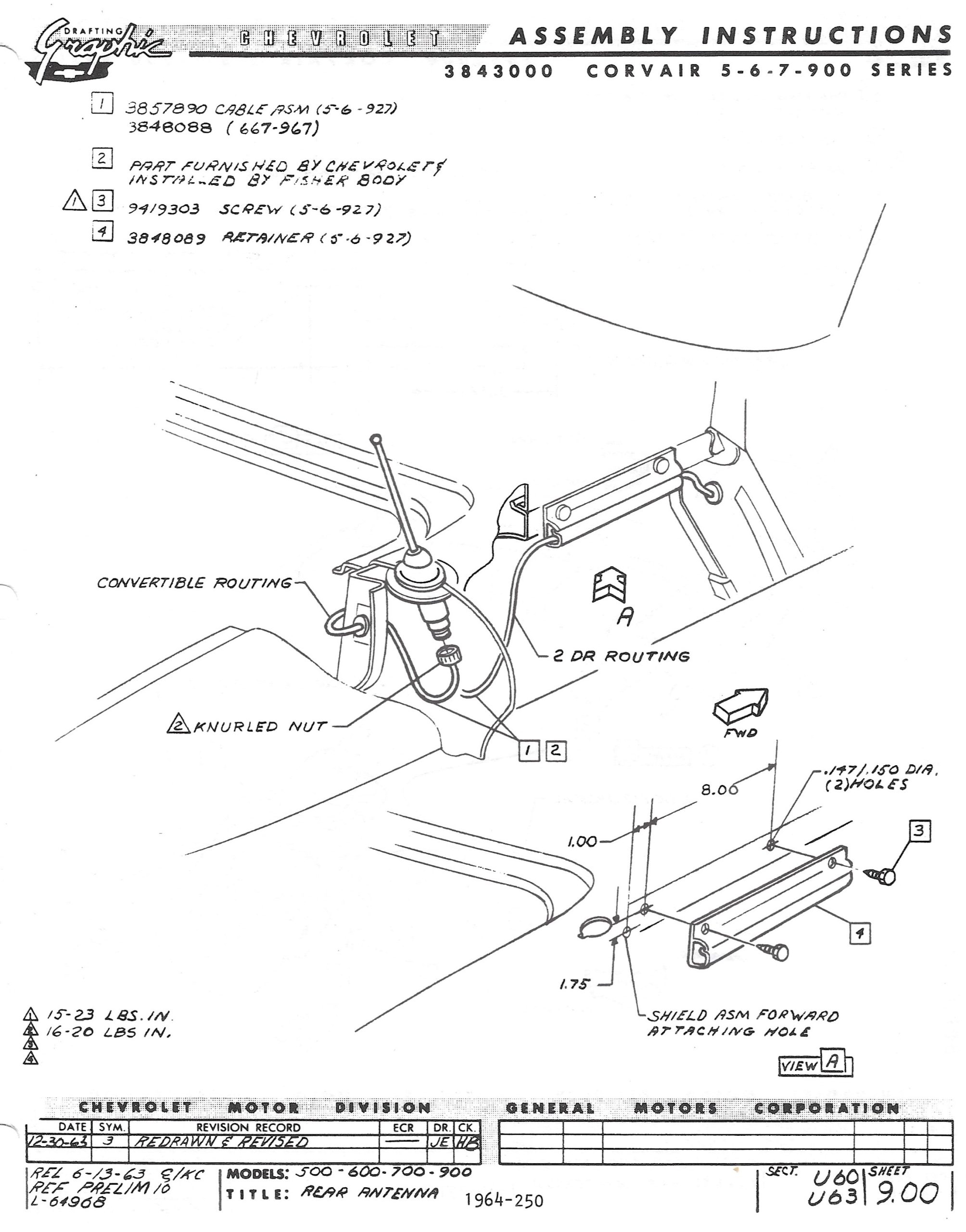
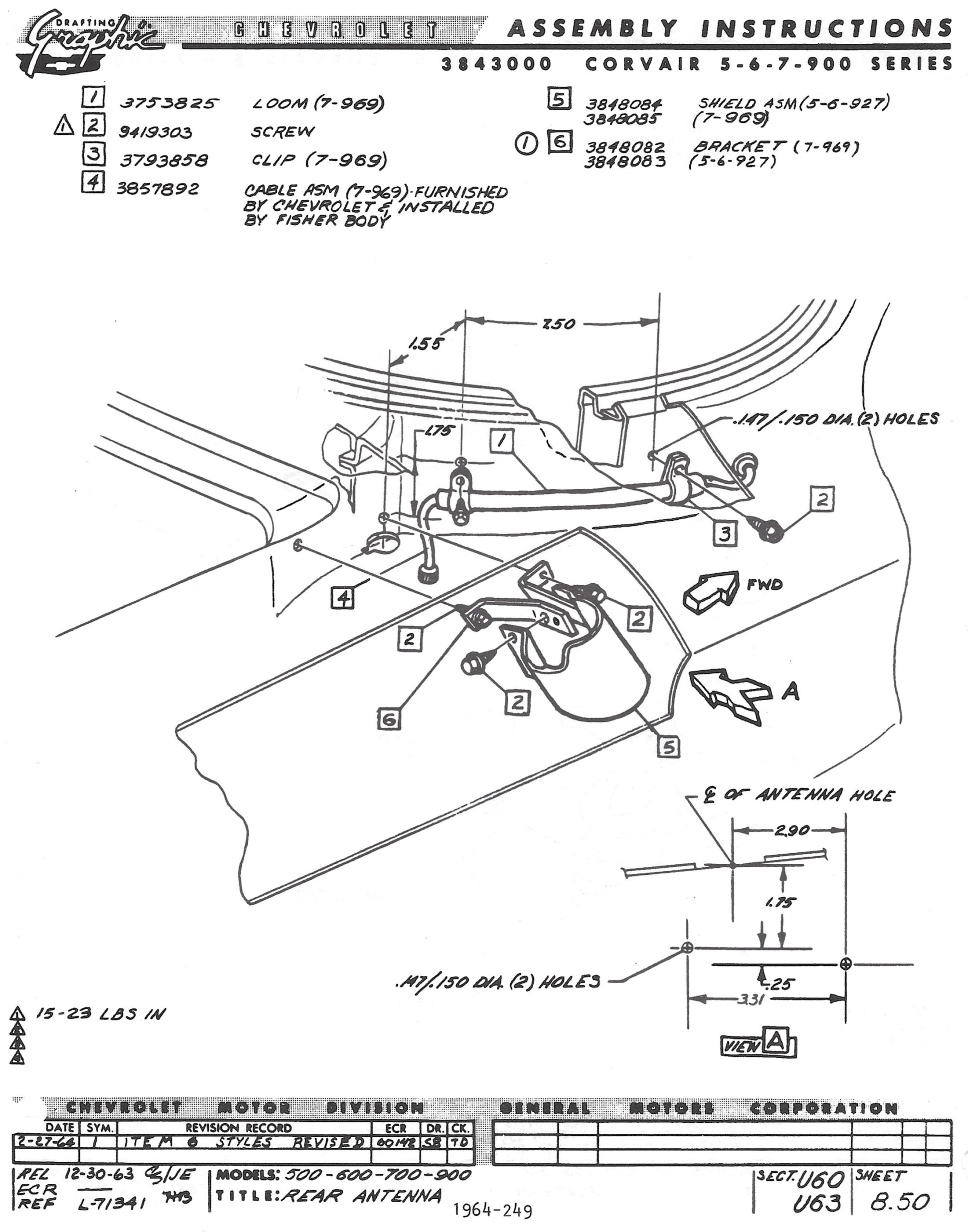
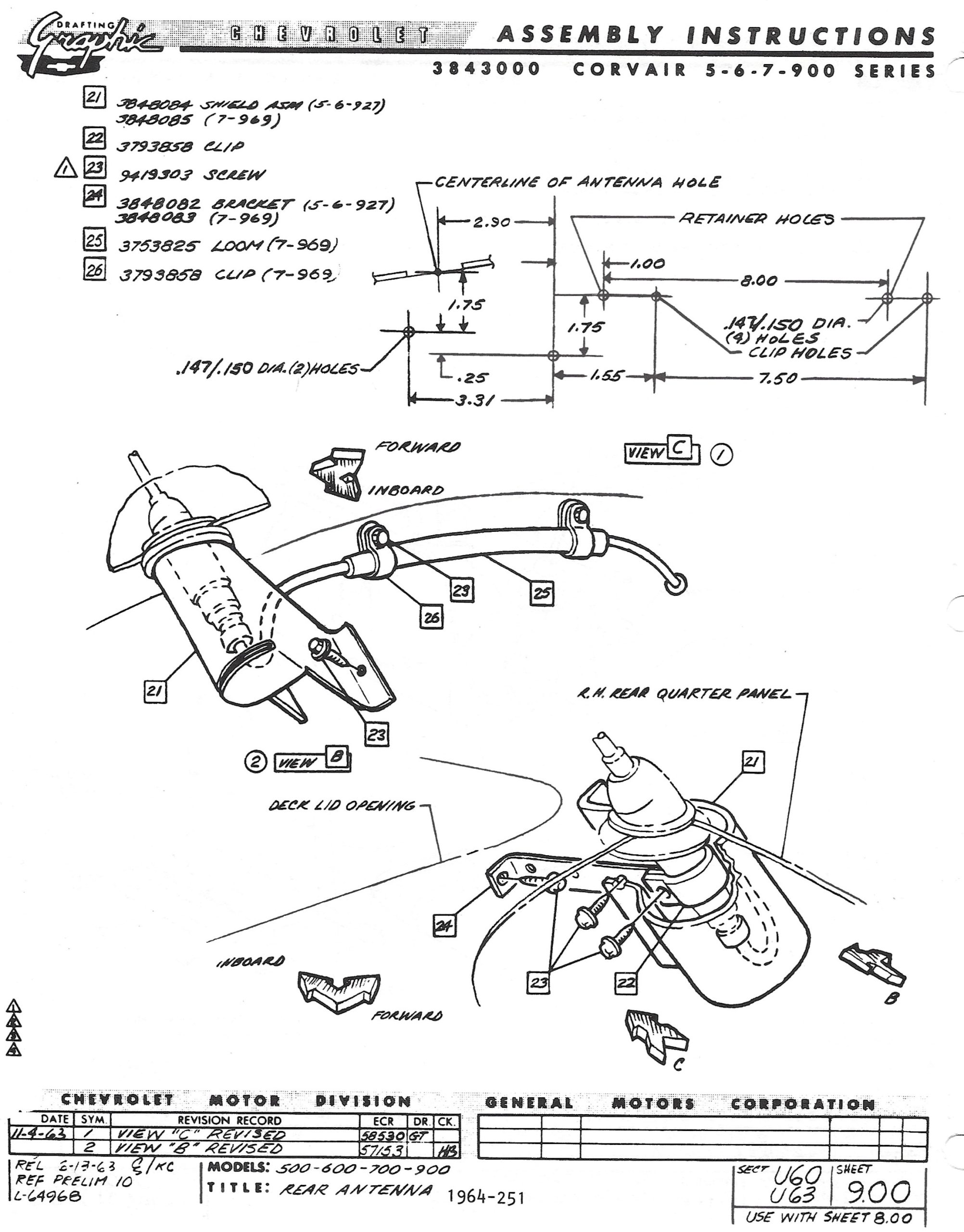
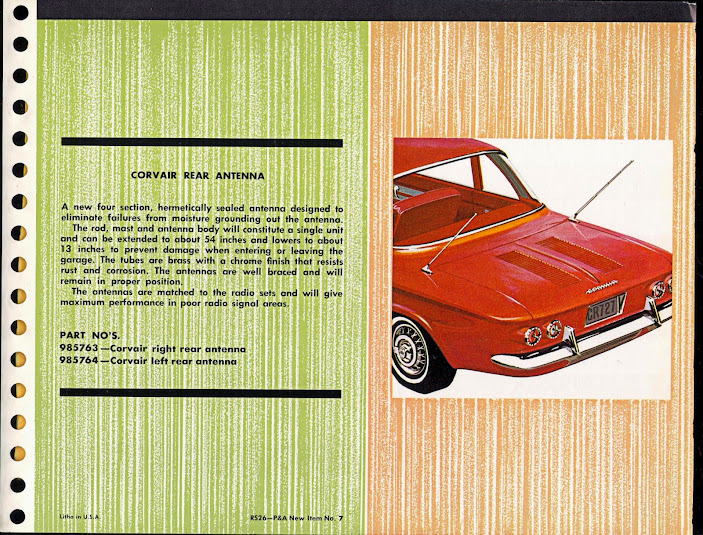
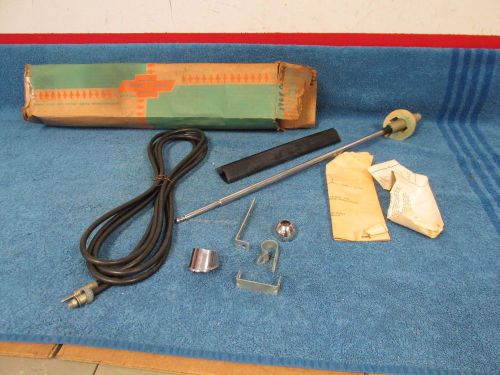
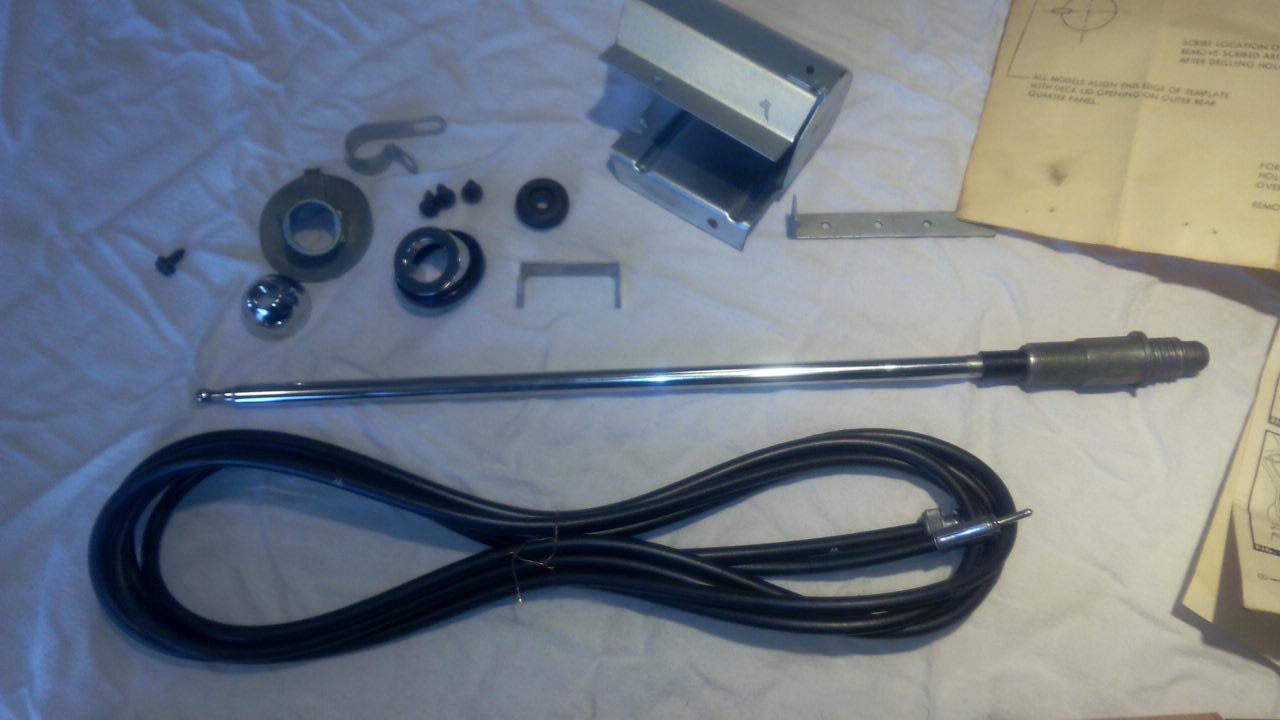
Click here to view the complete 1964 Rear Antenna Installation Instructions
1963-65 FC Antenna (985444)
This was installed on all FCs with AM radio. It is installed in the same location as the 1961-62 version but uses the 1963-64 combined mast and body antenna. Like the 1963-64 car front antenna, this one also uses a lower tube only for mounting purposes.
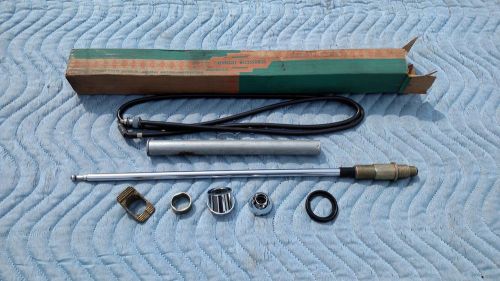
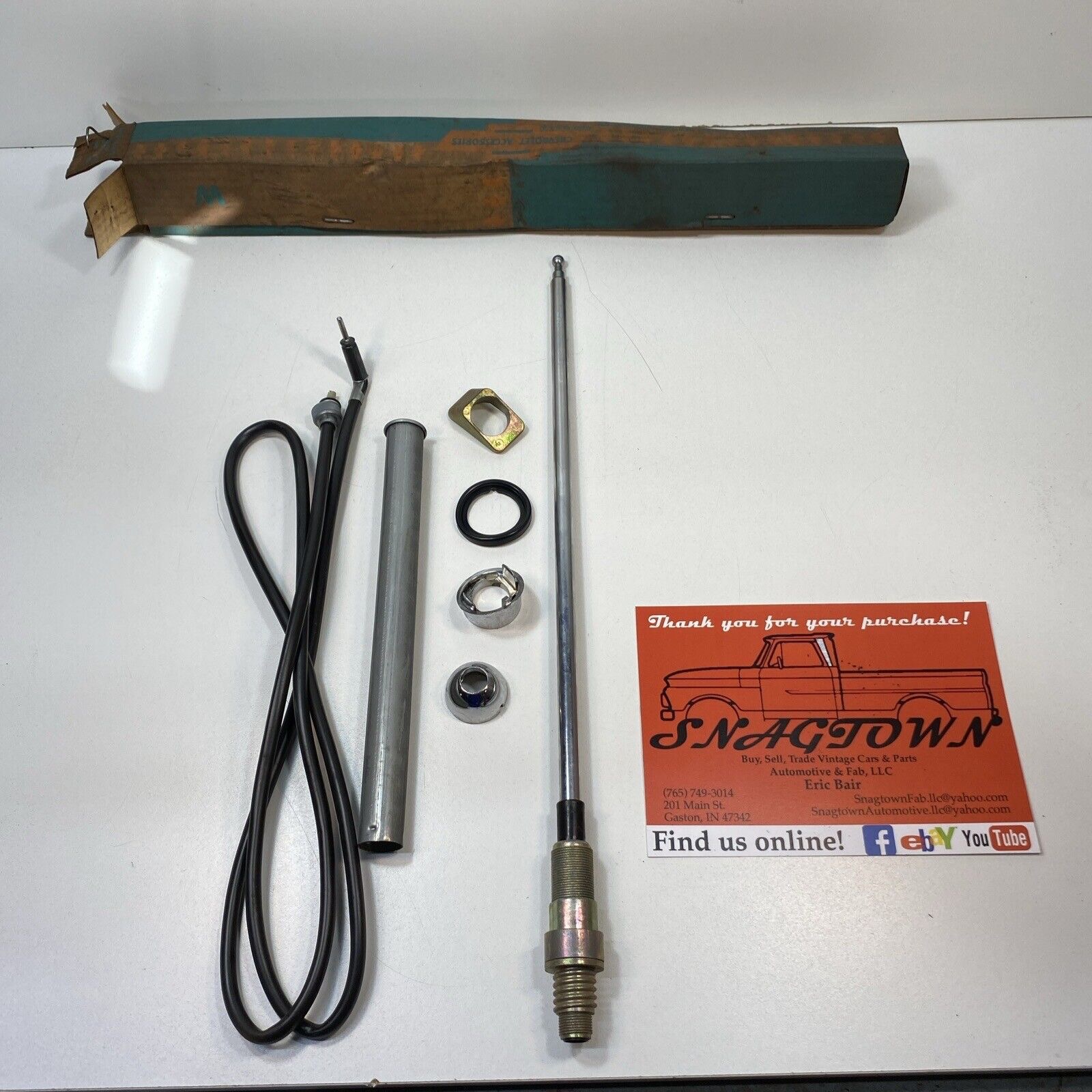
Click here to view the complete 1963, 1964, or 1965 FC Antenna Installation Instructions
Problems with Group 2 Design
While this design did a better job of keeping water out of the antenna body, it wasn’t 100% successful so occasionally some antennas did develop corrosion problems. The bigger issue, however, was that any damage to the mast required replacement of the complete antenna unit (time and $$), so this group gave way to Group 3 beginning in 1965.
Group 3: 1965-69 Cars
There are 10 antennas in this group: 1965-66 front AM, 1965-66 front FM, 1965 rear AM, 1966 rear AM, 1967-68 front AM, 1967-68 front FM, 1967-68 rear AM, 1969 front AM, 1969 front FM, and 1969 rear AM.
All of these antennas share a common design; they use a small antenna body to which an antenna mast is screwed in from above and they do not have any lower tubes or shields. The differences among these antennas are minor and will be explained below. This new design offered several advantages over previous designs:
- It simplified Dealer Prep as all antenna installation aside from the mast could be done at the factory.
- It reduced part inventory (and therefore costs) as many of the same parts could be used for front or rear, AM or FM antennas,
- It made antenna replacement much simpler
- It made it possible to easily remove the antenna to cover the car.
- It reduced the likelihood of water intrusion into the antenna body.
1965-68 antennas all use the same cap. Front antennas all use the same bezel, bezel gasket, and ground ring. Rear antennas mostly use the same bezel, and bezel gasket, but the 66-69 rear antennas use a different ground ring from 65s.
1965-68 antenna masts all have the same threaded base, so are interchangeable; 1969 antennas have a different base and will only fit the special 1969 antenna body.
For the most part, the only difference between an AM antenna and an FM antenna for any given year is the antenna mast. AM antennas were telescopic, FM were fixed length. There were four versions of telescopic mast (65-66, 67, 68, 69) and 3 versions of fixed length mast (65-67, 68, 69)
There were three versions of antenna body (65-early 66, mid-66-68, and 69).
Let’s examine then in detail:
1965-66 front AM (986114) and FM (986462) Antennas
These were used on 1965 and 1966 cars with AM or AM/FM radios. They were installed on the right fender, in the fresh air plenum.
Aside from the masts, they were identical in every way except for the antenna body, which changed early in the 1966 model year from the 1965 version (386323 – with threaded connection for antenna cable) to the 1966-68 version (3880695 – with push-on connection for antenna cable).
The masts deserve some extra explanation. 1965 started off using only the telescoping version (3863099) for both AM and FM, and also offered this for AM or FM reception in the rear antenna position. However, it soon became apparent that this was not providing good FM reception, so around December of 1964 they started supplying the fixed antenna (3875700) for cars with AM/FM radio and eliminated the rear antenna option for AM/FM radio cars. The telescoping antenna continued to be available for AM cars, front or rear, through end of 1966 model year.
Telescoping mast 3863099 is a round, 4 section antenna finished in bright chrome, about 18″ collapsed and 57″ fully extended.
Fixed mast 3875700 is a thin “whip” antenna, made of stainless steel, 31″ long.
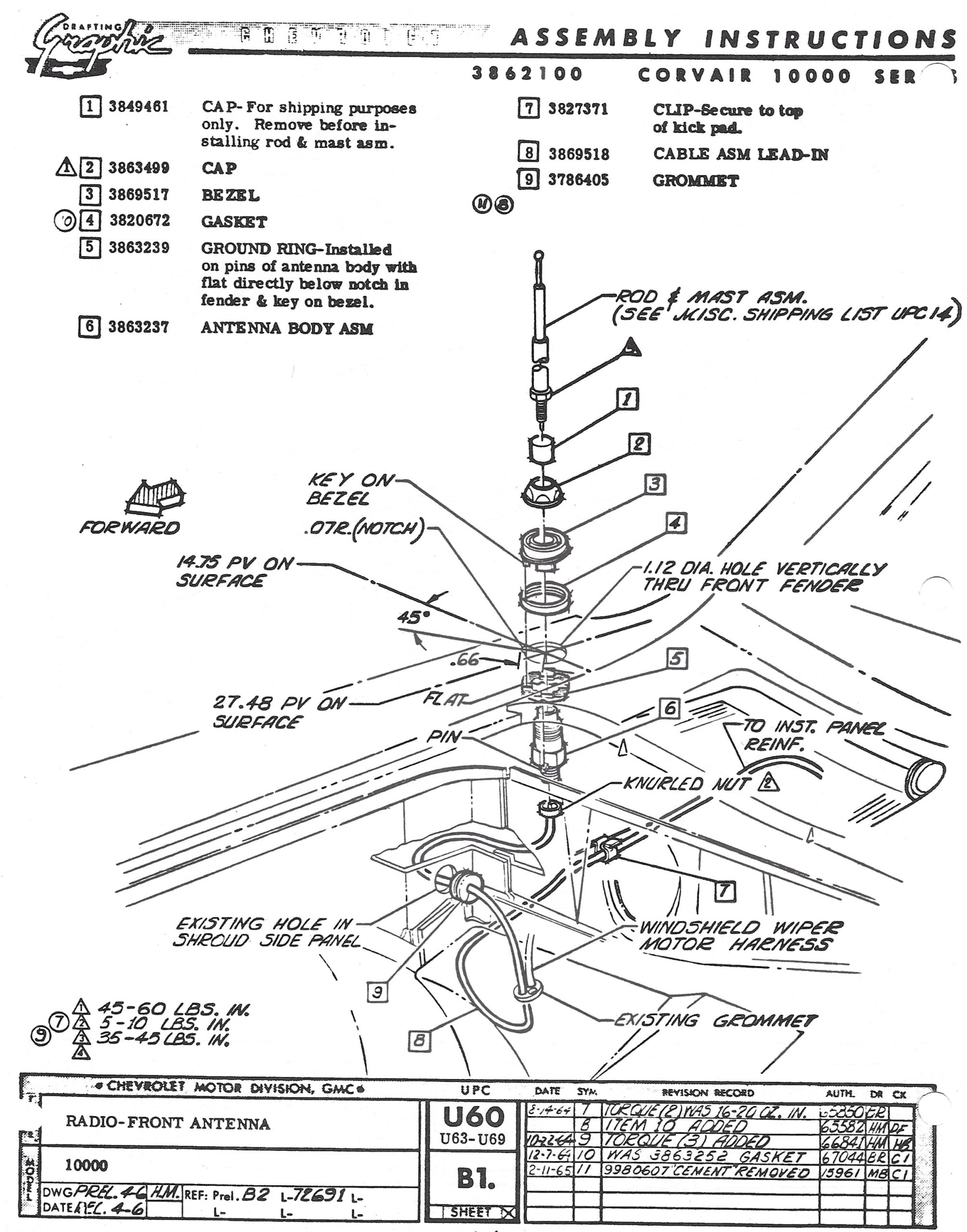
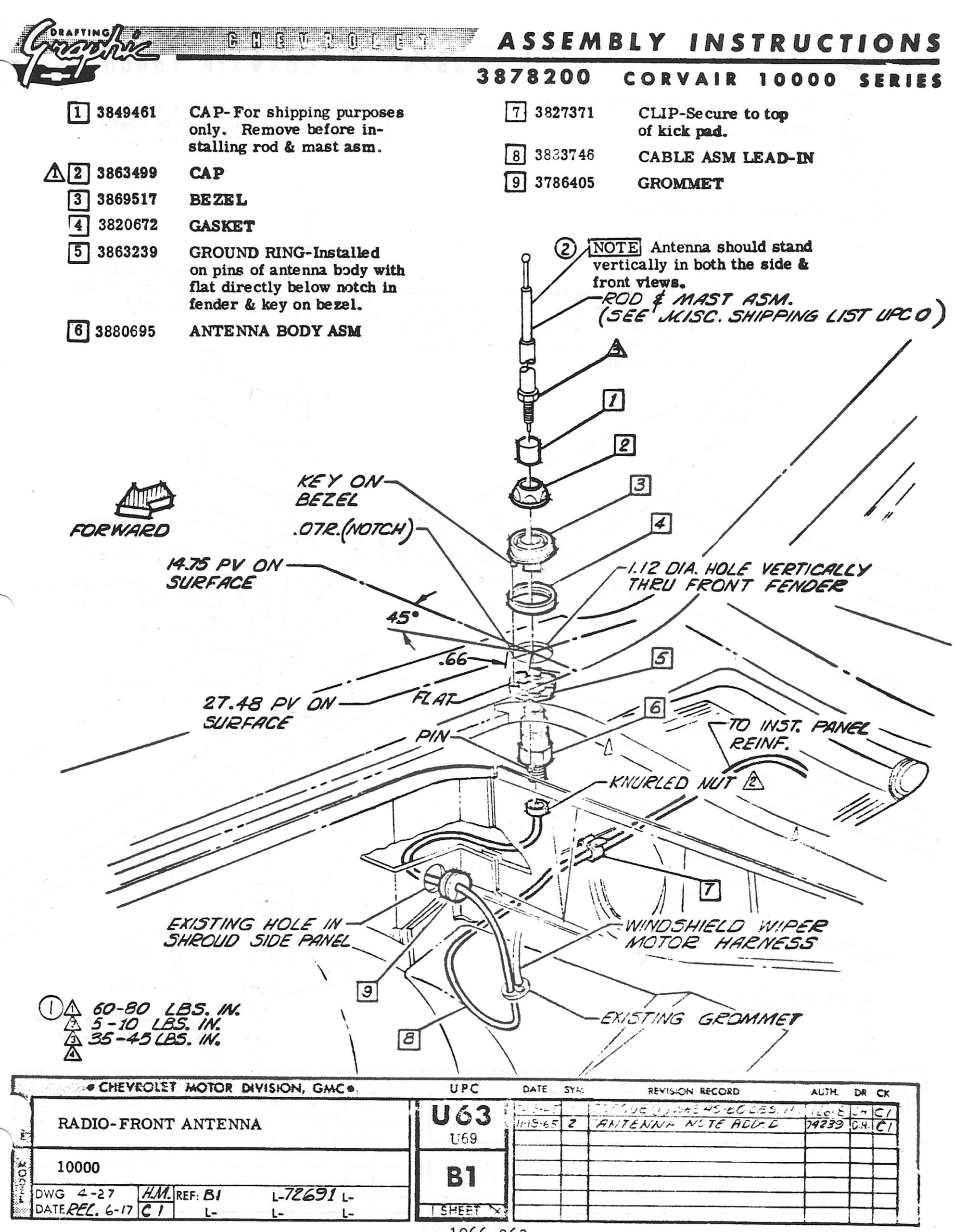
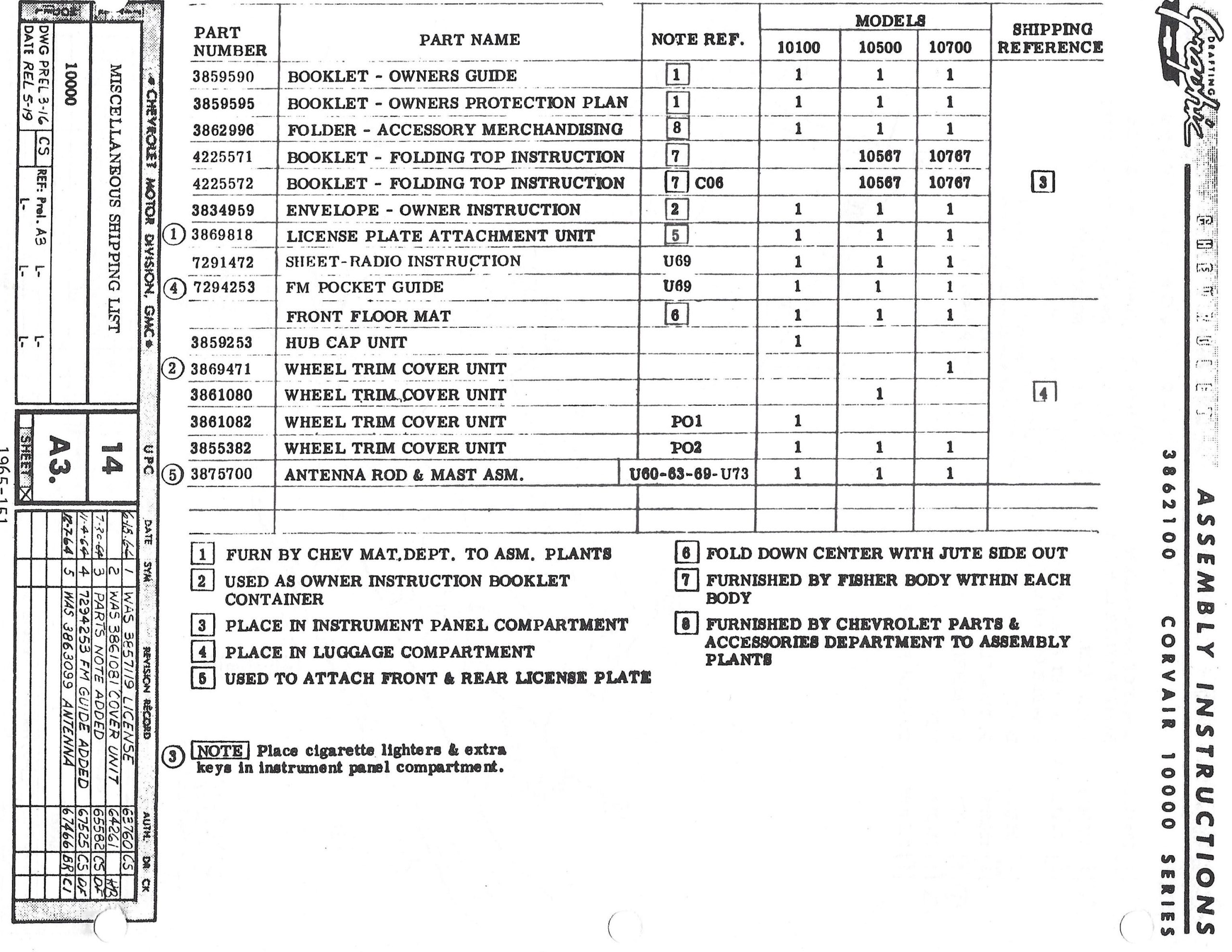
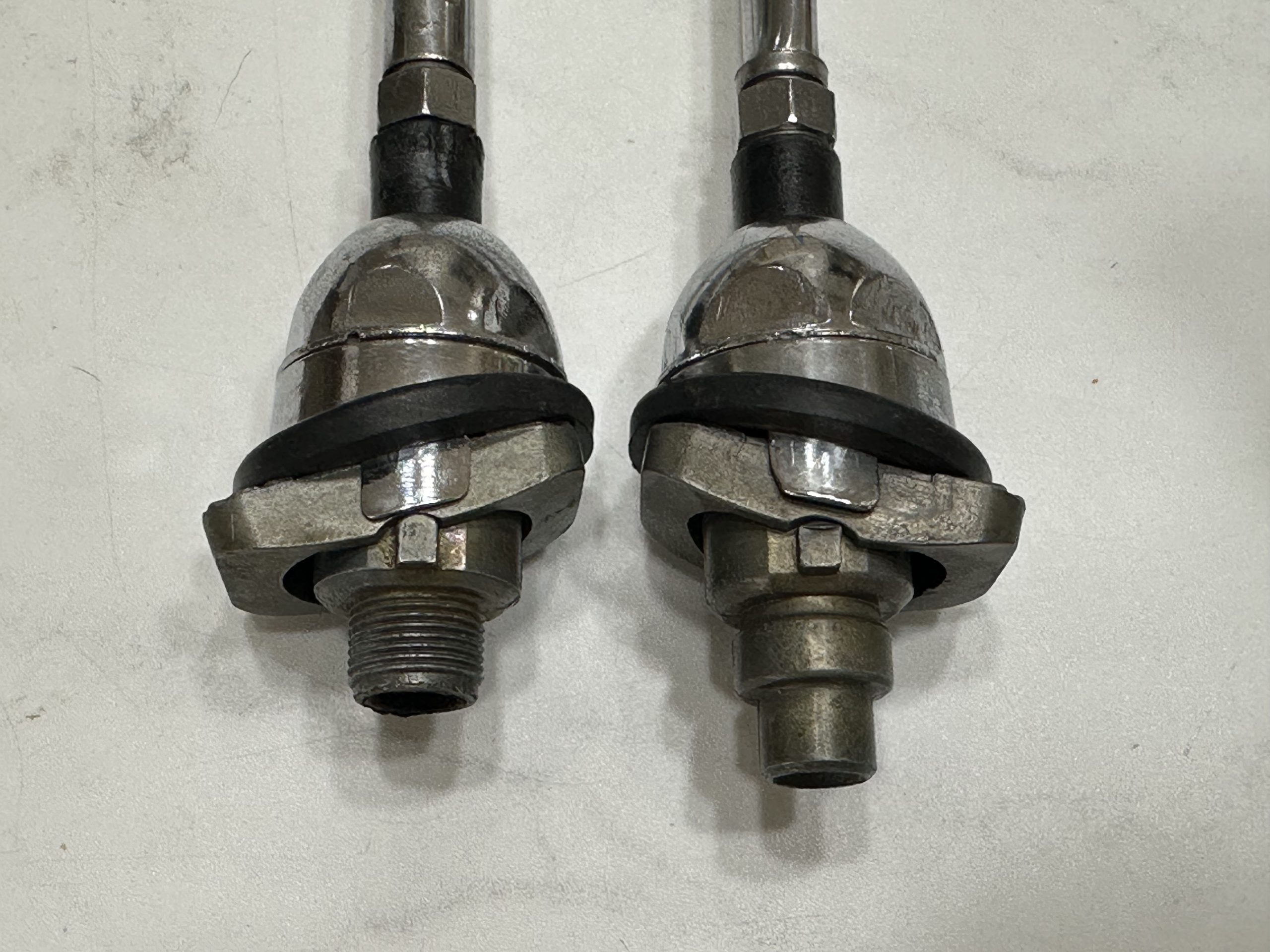
Click here to view the complete 1965 Front Antenna Installation Instructions
1965 (986120) and 1966 (986685) Rear Antennas
Installed on the right rear quarter, this antenna was used on 1965 and 1966 cars with AM radios and rear antenna option.
As noted above and as discussed in this link, it’s possible that a few early 1965 cars with AM/FM radios were shipped with the rear antenna). This early 1965 sales brochure indicates that AM/FM radios could be ordered with front or rear antenna; this is not definitive proof, however, as sales brochures were printed well in advance of production.
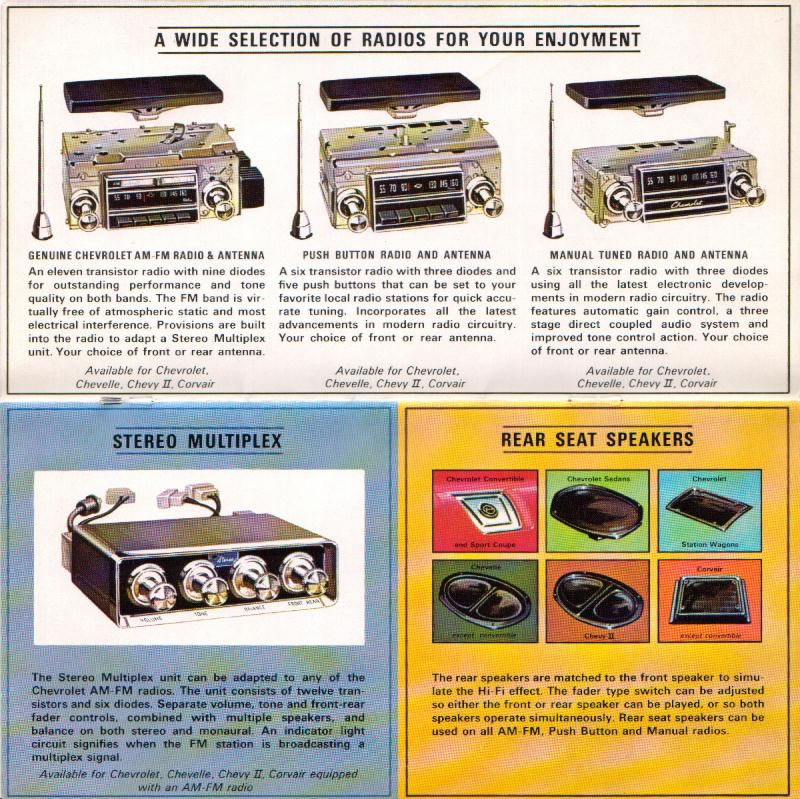
1965 and 1966 rear antennas both used telescopic mast 3863099, same as the front. The only difference between these two antennas is the previously mentioned antenna body change and also a change in the ground ring; essentially combining the 1965 version ground ring with a reinforcing washer. This revised ground ring continued to be used on all subsequent year rear antennas.
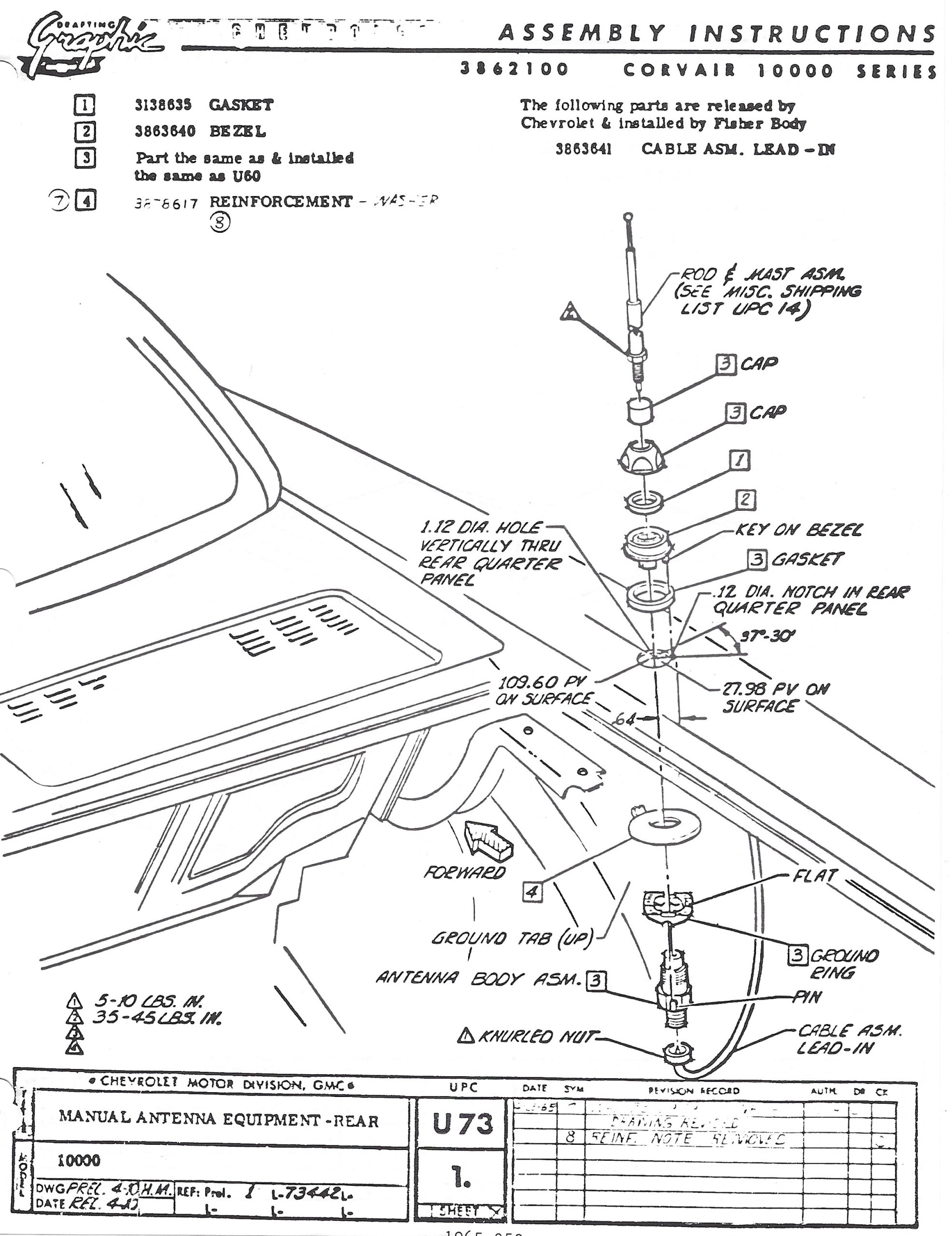
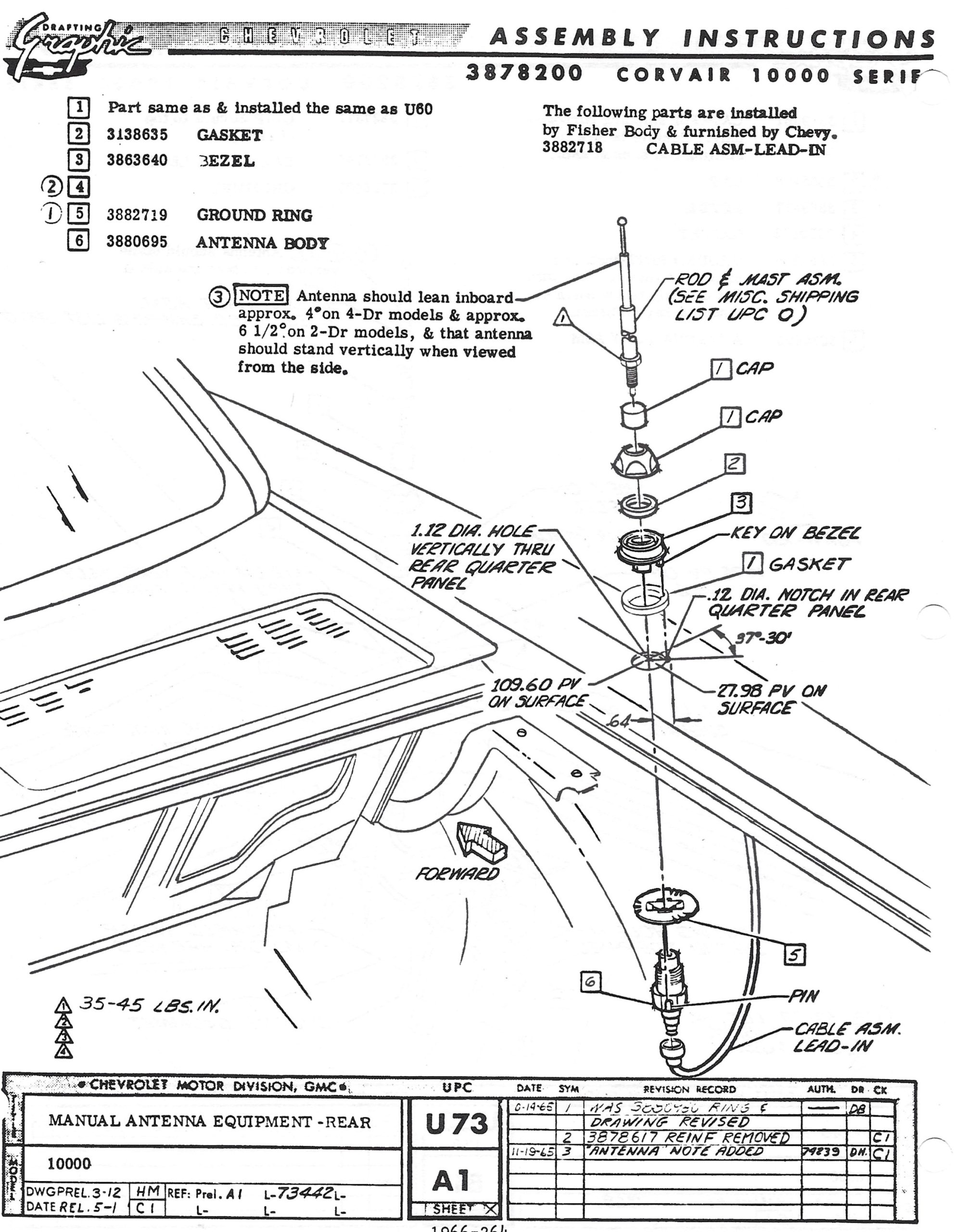
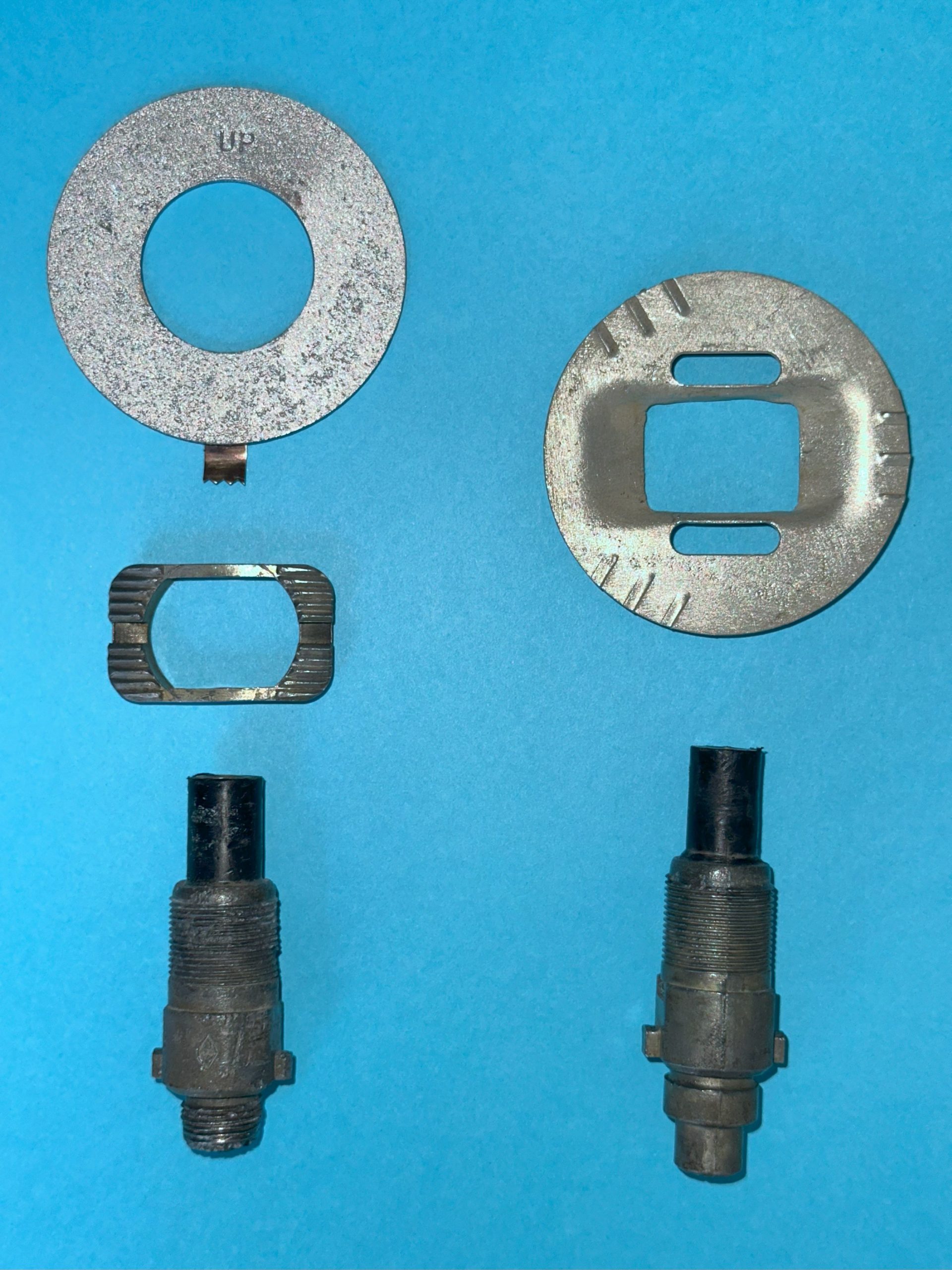
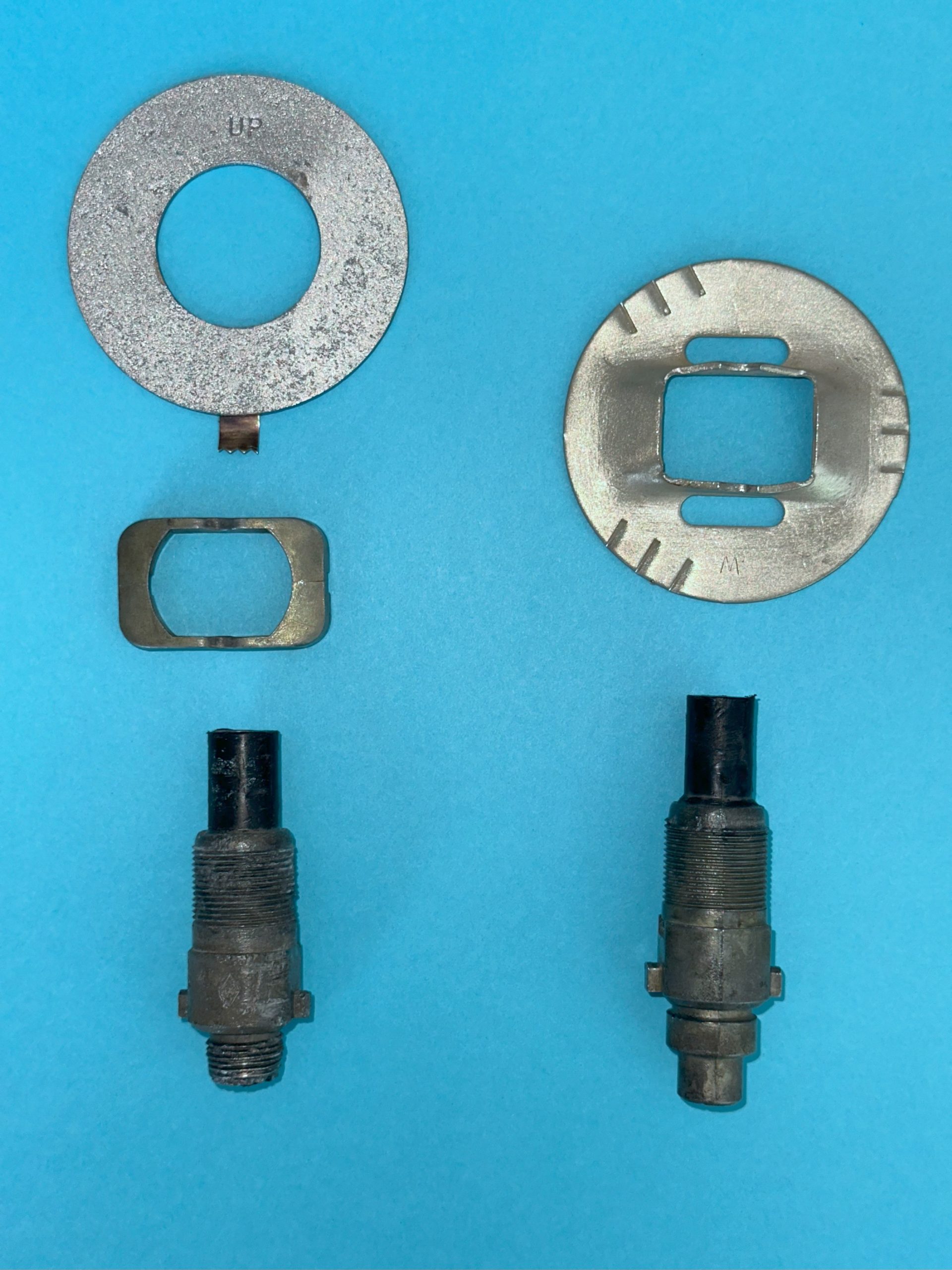
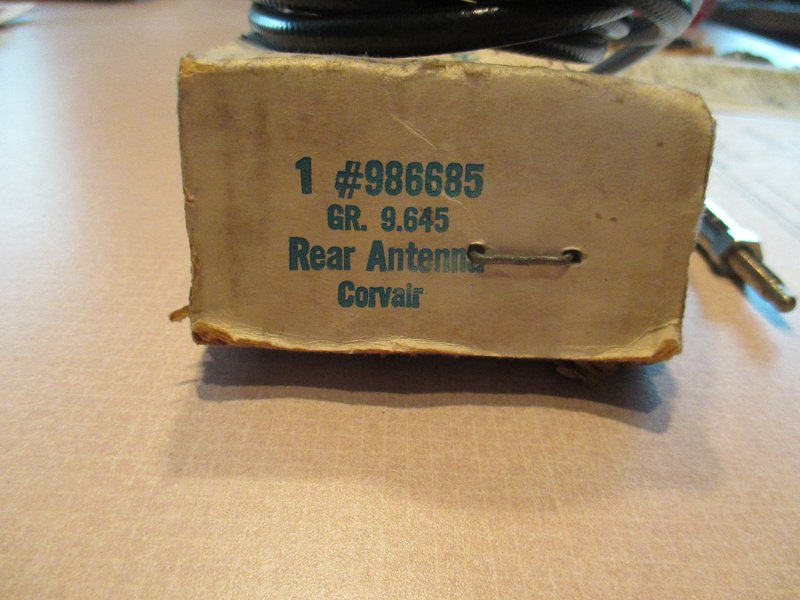
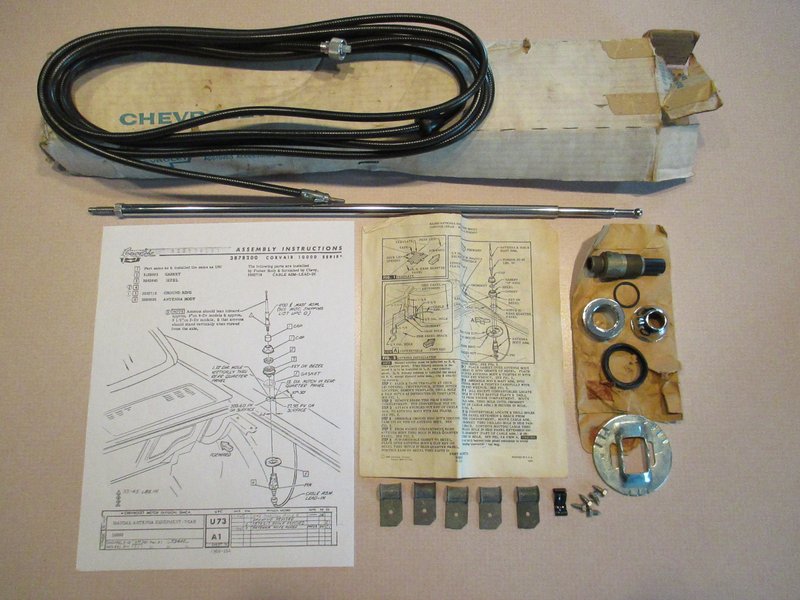
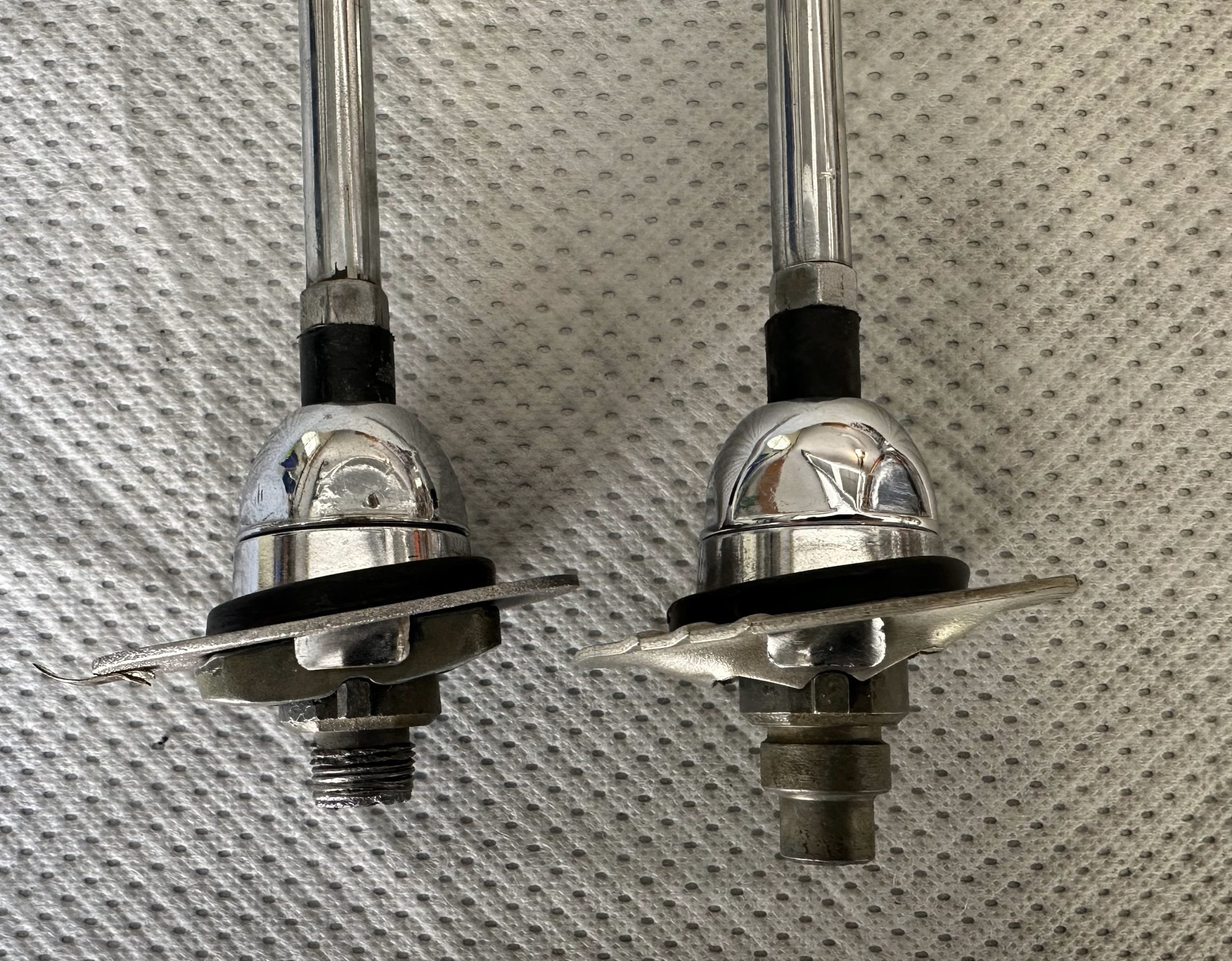
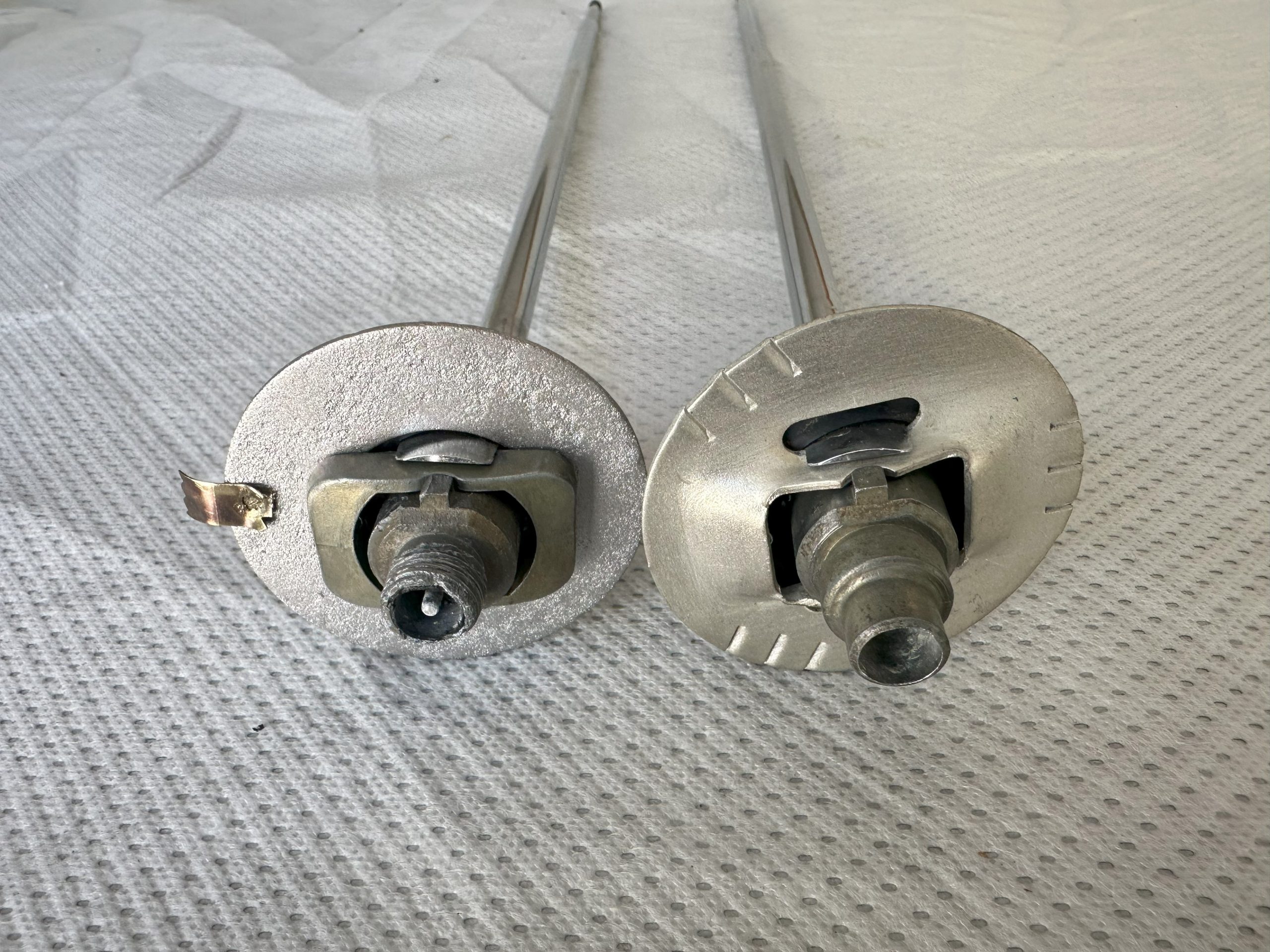
Click here to view the complete 1965 Rear Antenna Installation Instructions
1967-68 Front AM (986925) and FM (986927) Antennas
These were used on 1967 and 1968 cars with AM or AM/FM radios. They were installed on the right fender, in the fresh air plenum.
Aside from the masts, they were identical in every way:
- 1967 AM mast 3876412 was 3 section oval antenna bright chrome, 19″ collapsed, 46″ extended.
- 1968 AM mast 3934224 was 3 section oval antenna satin chrome, 19″ collapsed, 46″ extended.
- 1967-68 FM mast continued to be 3875700 – thin “whip” antenna, stainless steel, 31″ long.
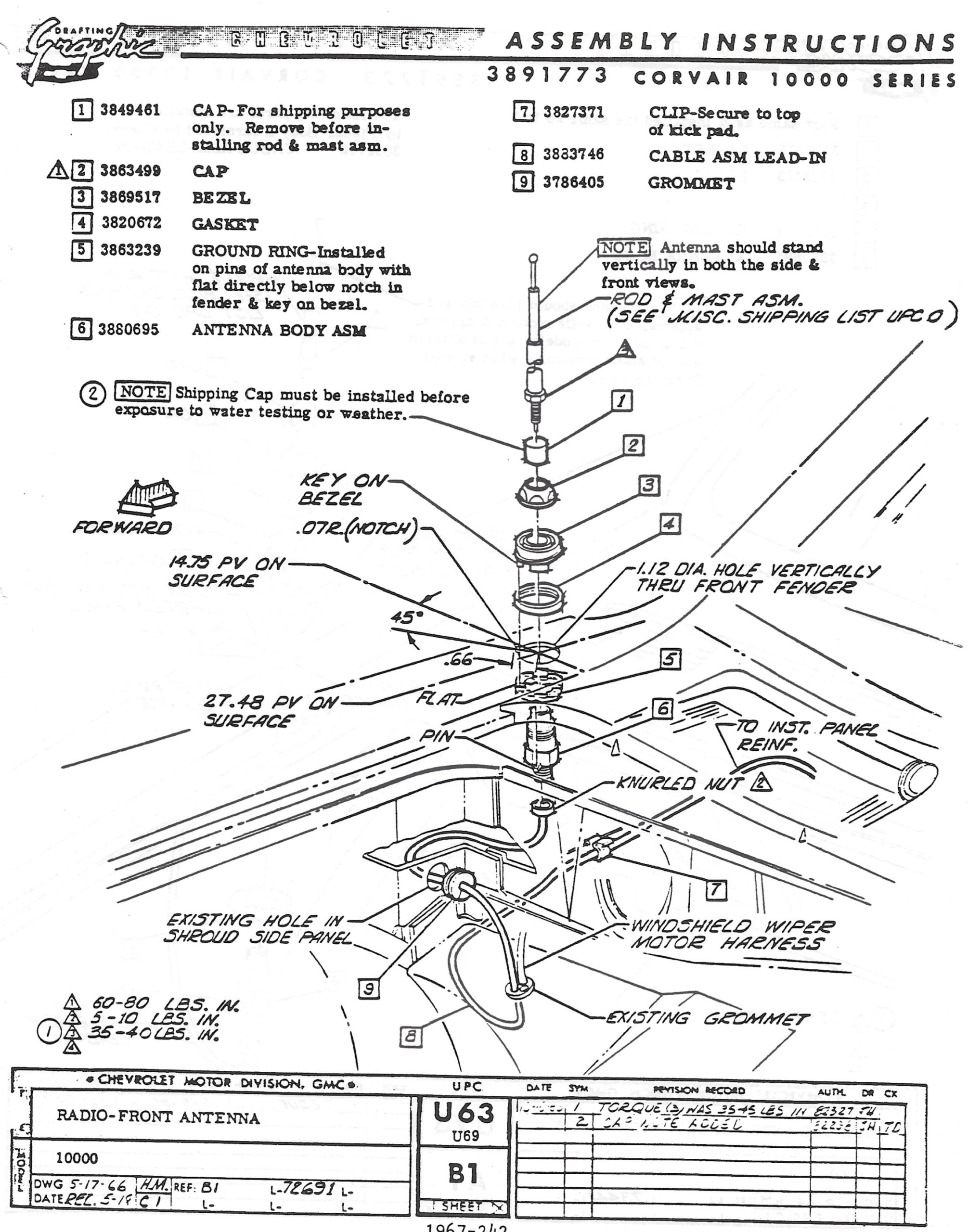
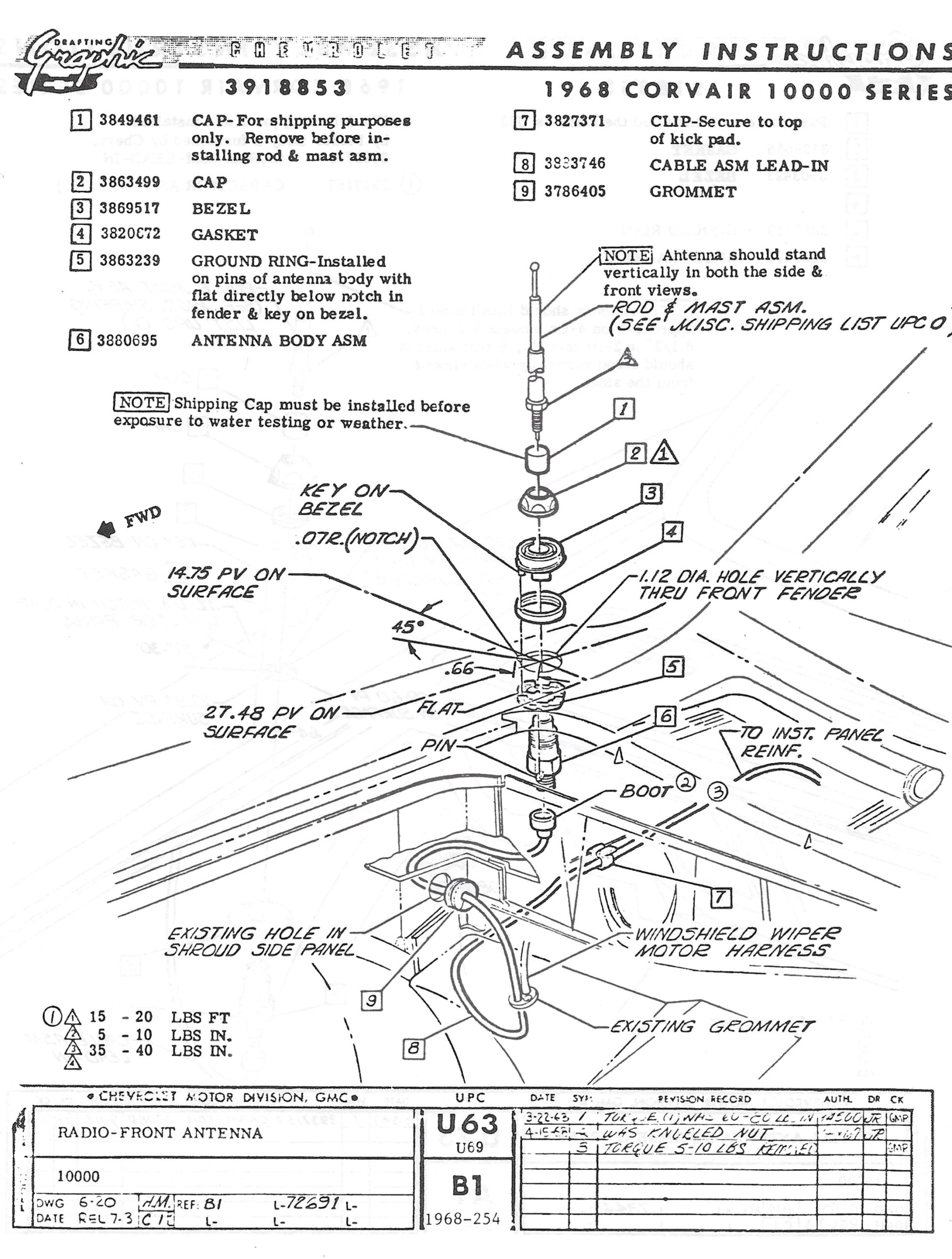
1967-68 Rear Antennas (986926)
These were installed on 1967-68 cars with AM radio and rear antenna option. They were installed on the right rear quarter.
Aside from the masts, they were identical in every way. The rear antennas masts were identical to the front antenna masts for the respective year:
- 1967 AM mast 3876412 was 3 section oval antenna bright chrome, 19″ collapsed, 46″ extended.
- 1968 AM mast 3934224 was 3 section oval antenna satin chrome, 19″ collapsed, 46″ extended.
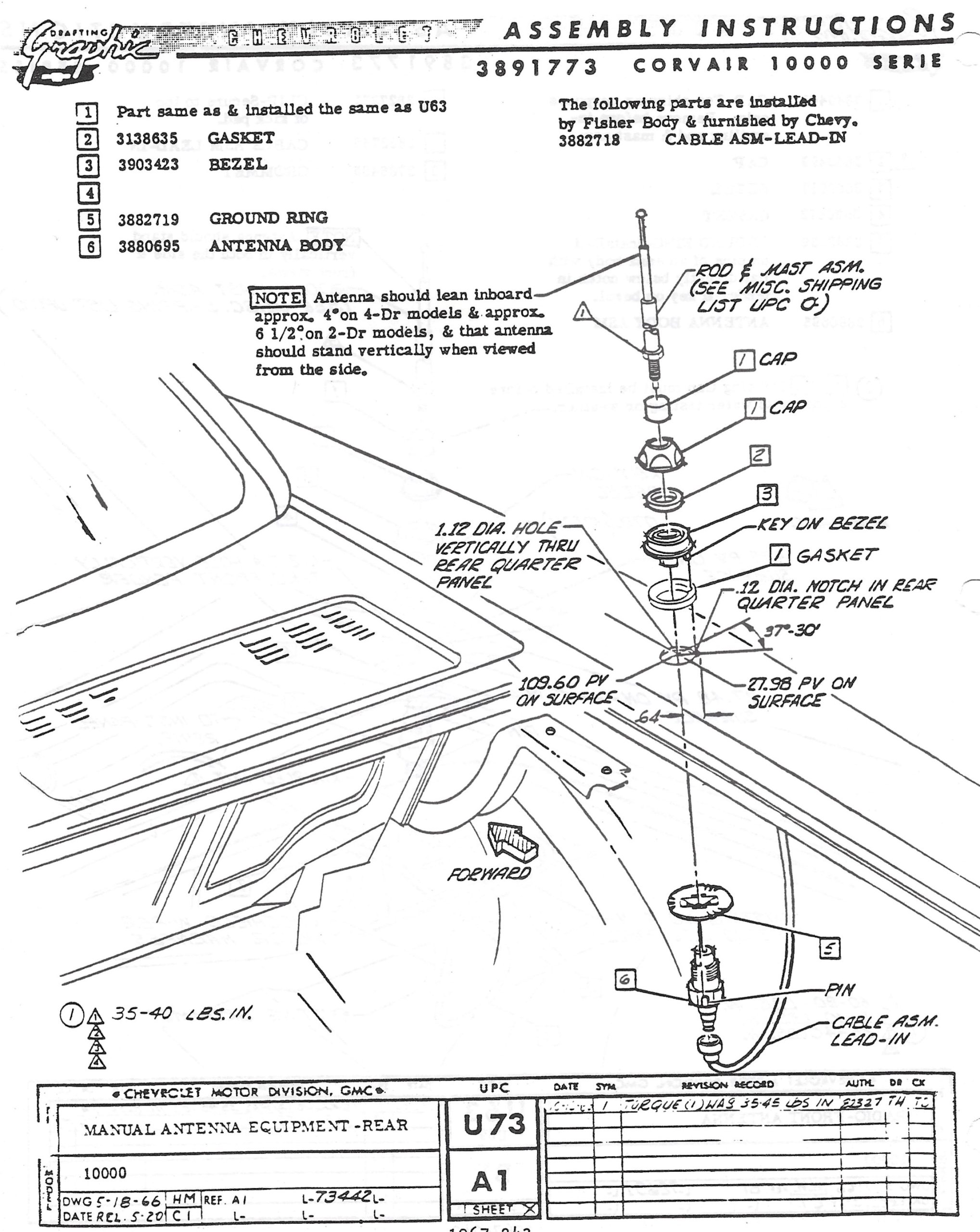
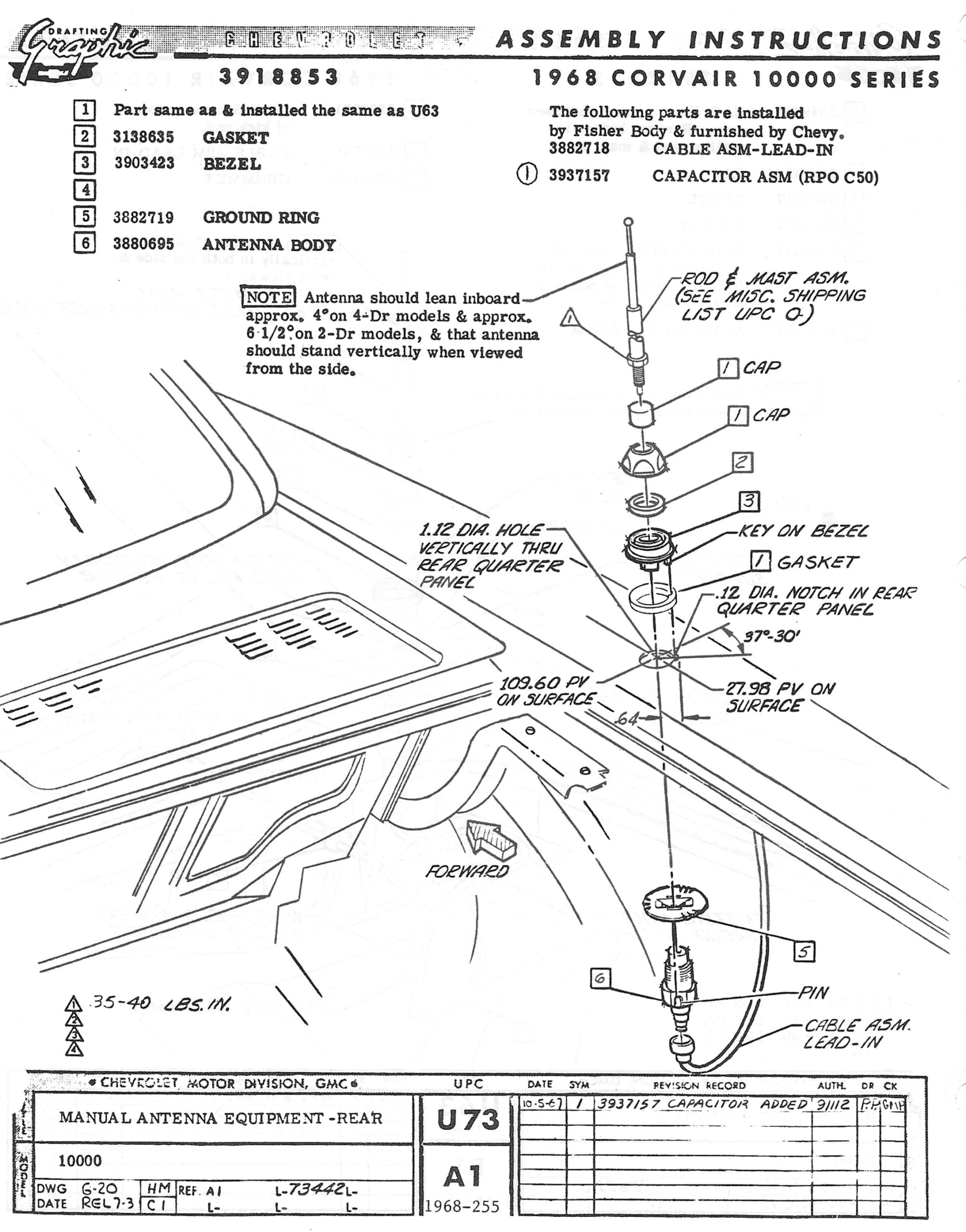
1969 Front AM (993631) and FM (993632) Antennas
These were used on 1969 cars with AM or AM/FM radios. They were installed on the right fender, in the fresh air plenum.
The early 1969 cars were likely using up leftover 1968 parts, so we see a mix of 1968 and 1969 antennas. However, at some point they switched over to the 1969 parts as described here. The primary changes from 1968 are:
- Antenna masts and bodies were changed such that the antenna had a shaft that dropped into the body and a conical nut slid over the mast and screwed onto the body to secure the mast.
- The antenna wire was permanently secured to the antenna body
- The cap was changed to a large hexagonal “nut” shape.
This change in antenna mast and body was likely another attempt to keep water from getting into the threads of the antenna mast and body.
Aside from above the shape, dimensions, and finish of the antenna masts remained identical to the 1968 masts.
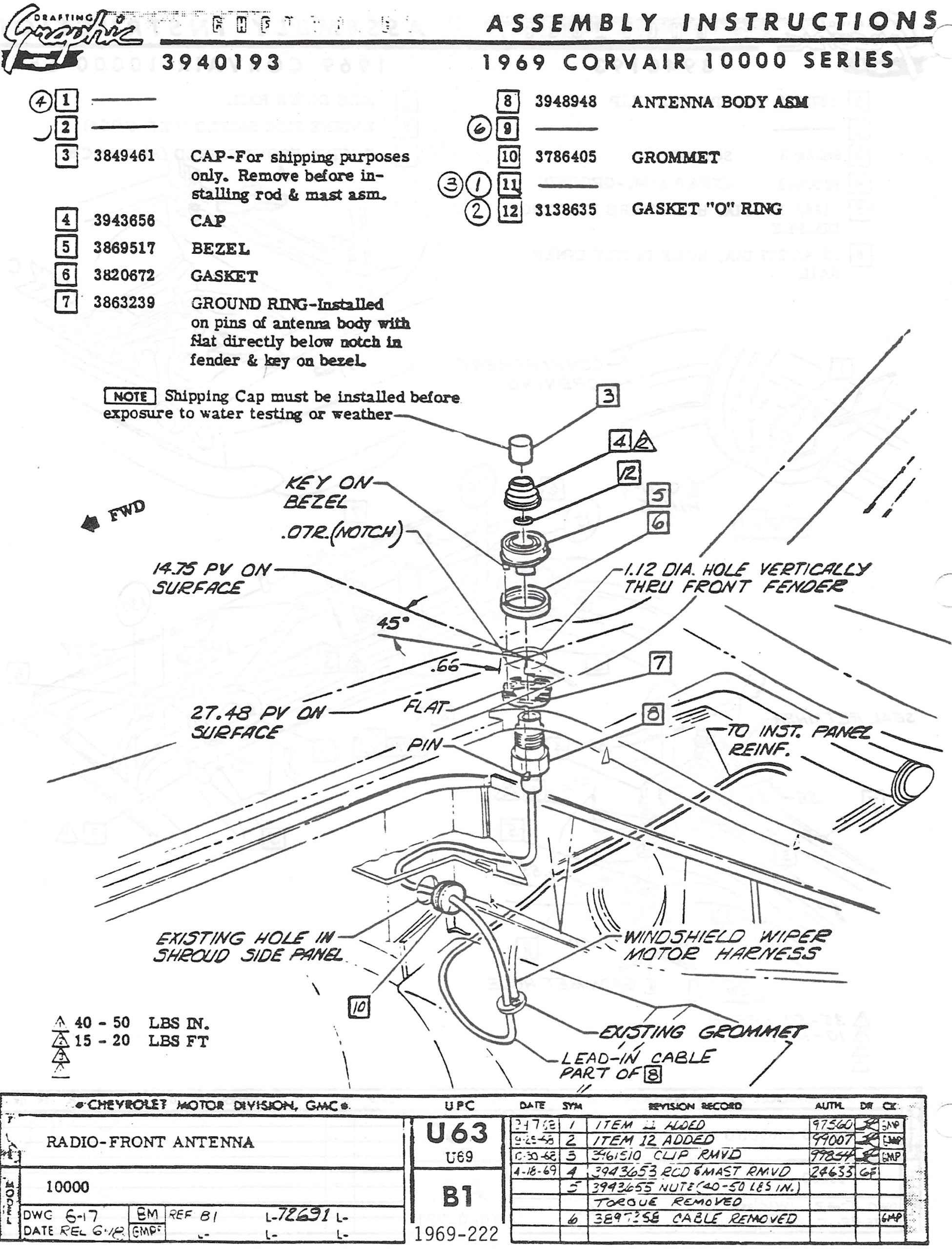
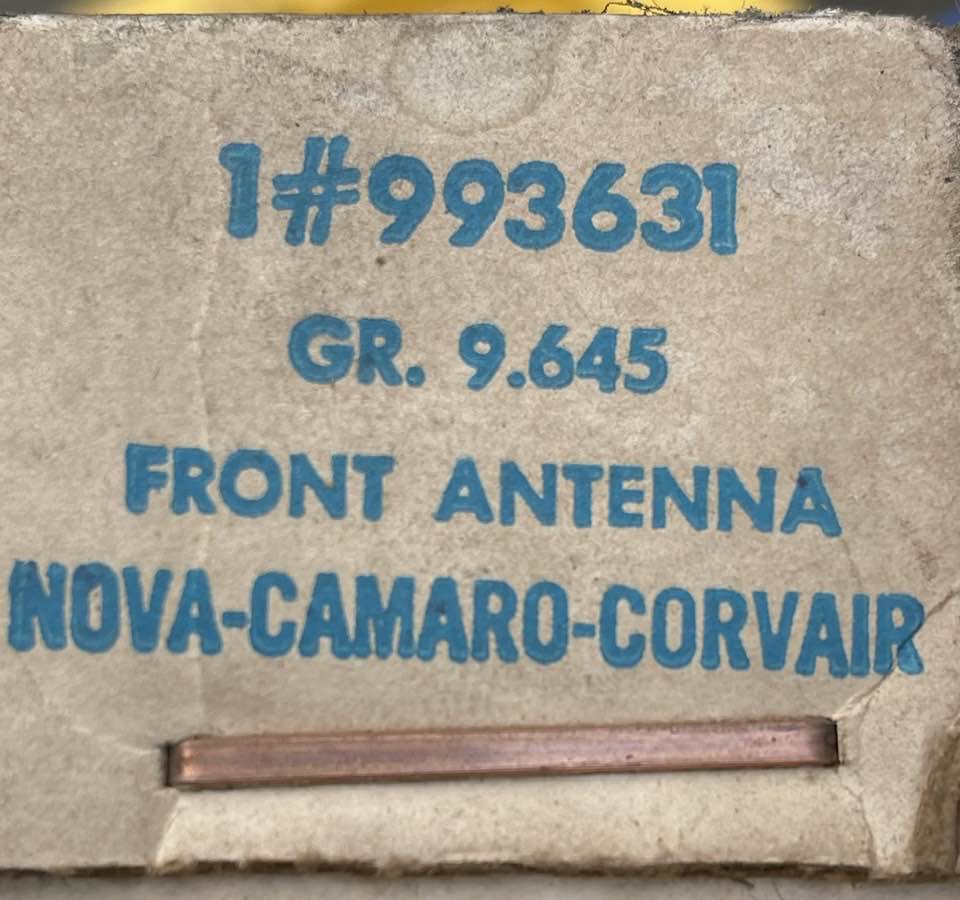

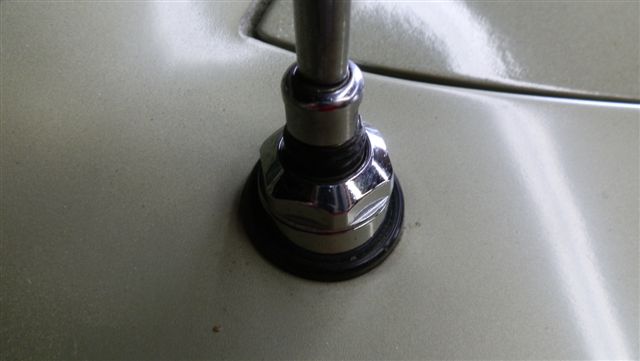
1969 Rear Antenna (993683)
These were installed on 1969 cars with AM radio and rear antenna option. They were installed on the right rear quarter.
They are identical to 1968 except for the antenna body and mast changes mentioned above.
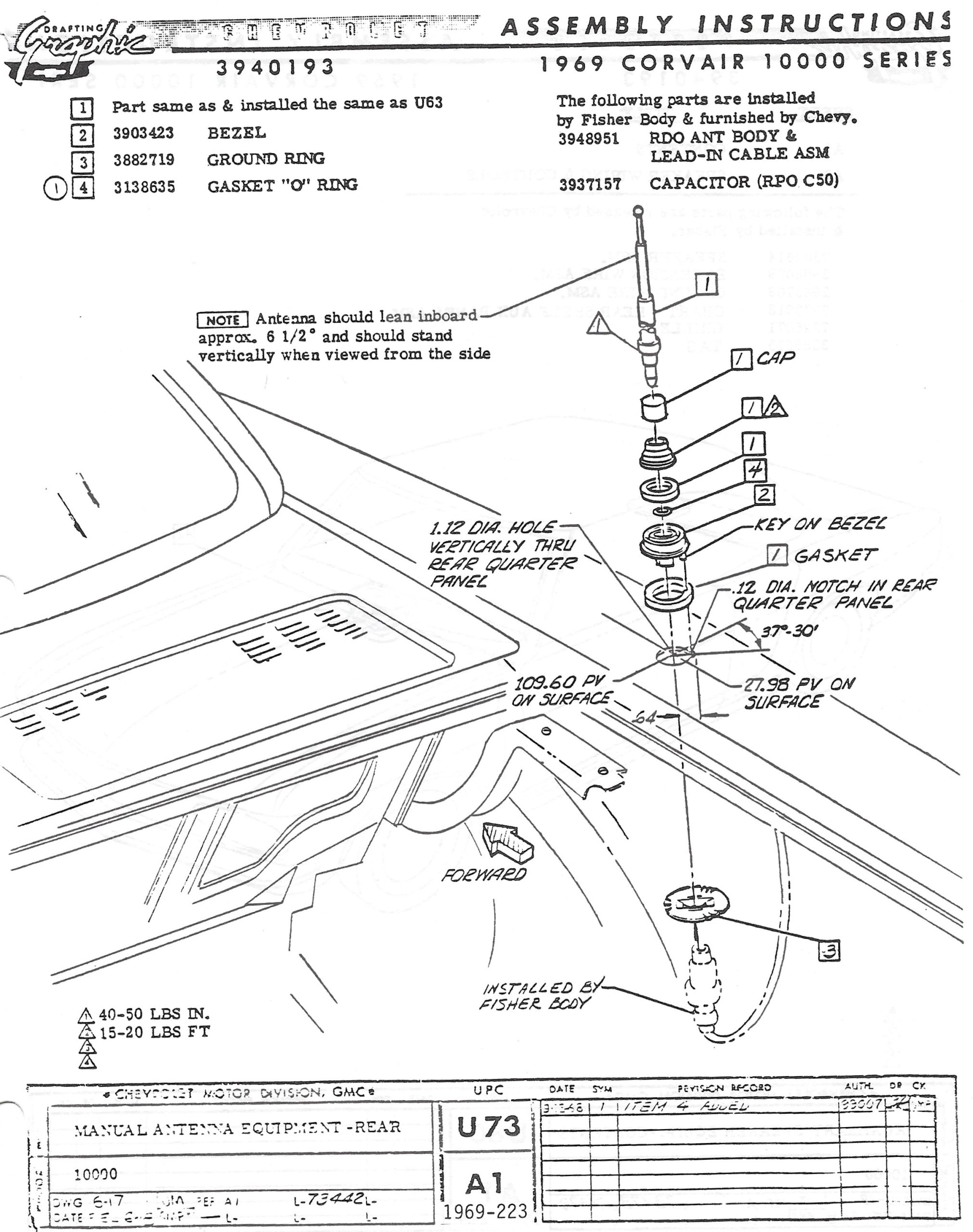
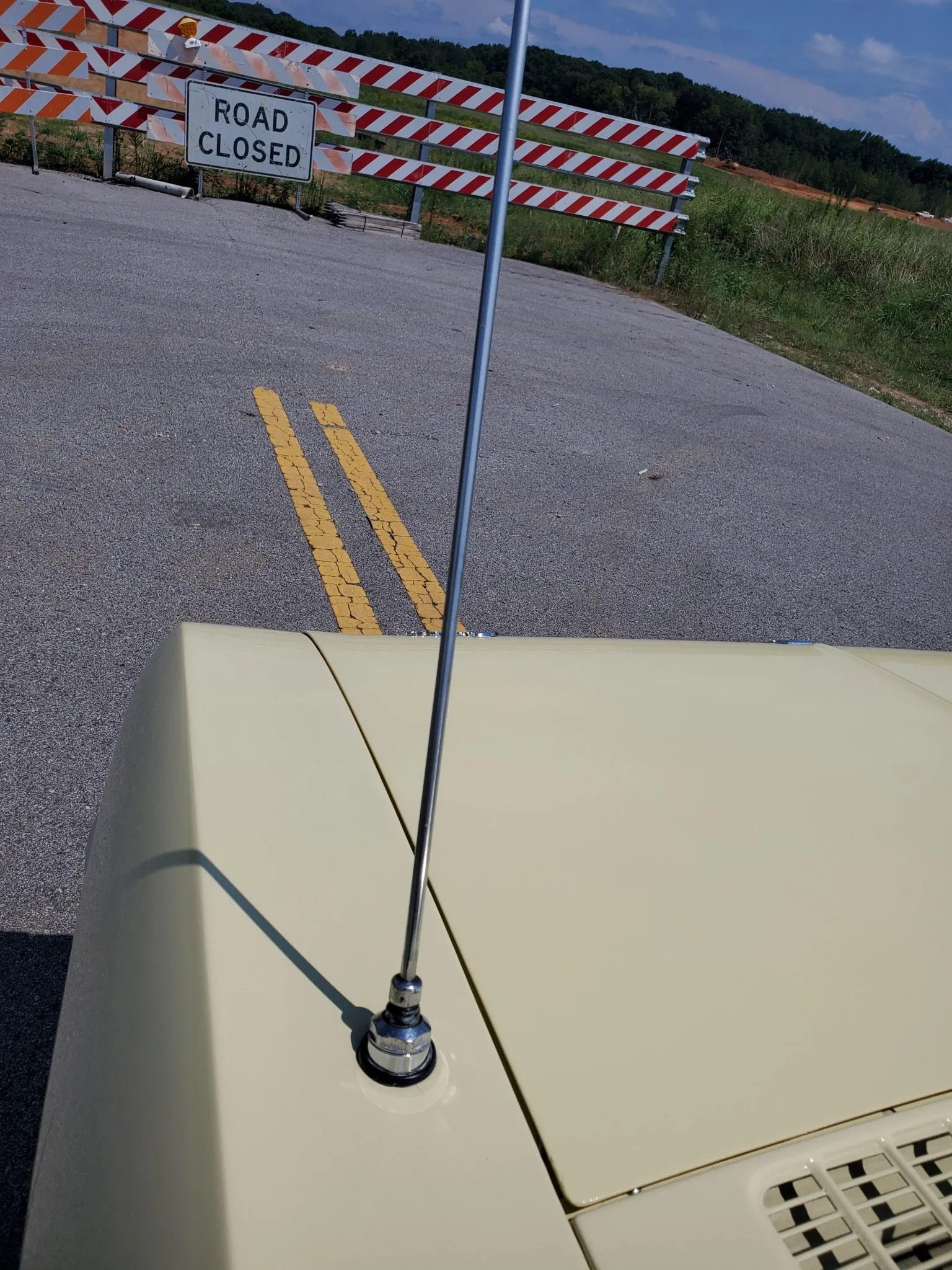
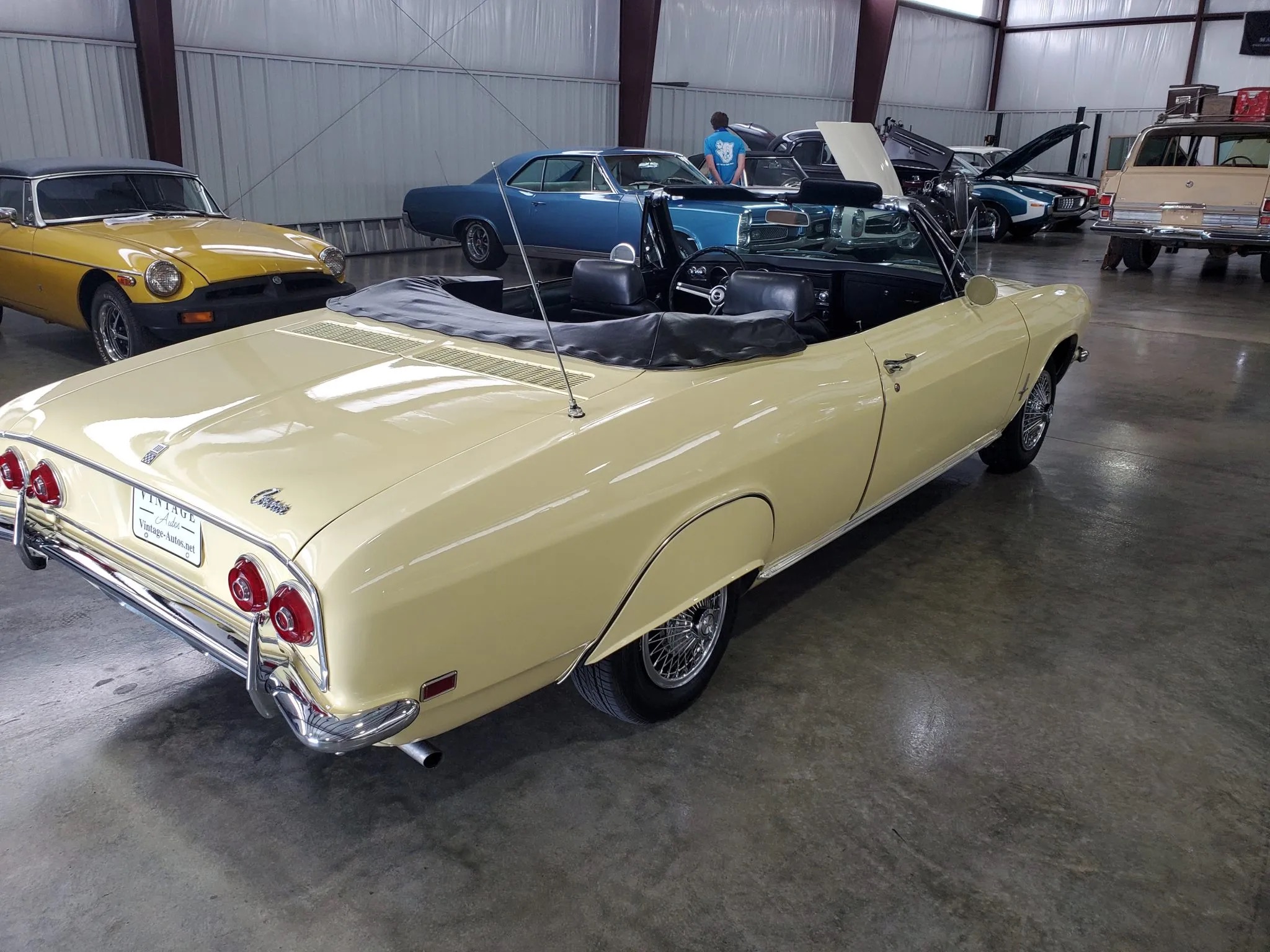
1966 Power Rear Antenna (3879544)
No article about Corvair antennas would be complete without at least a brief mention of the short-lived 1966 power rear antenna. Only 416 were produced, so they are very rare. I have never seen one in person, and I don’t have much information to share, but I’ve found a few photos online, and here also are the pages from the 1966 Assembly Manual.
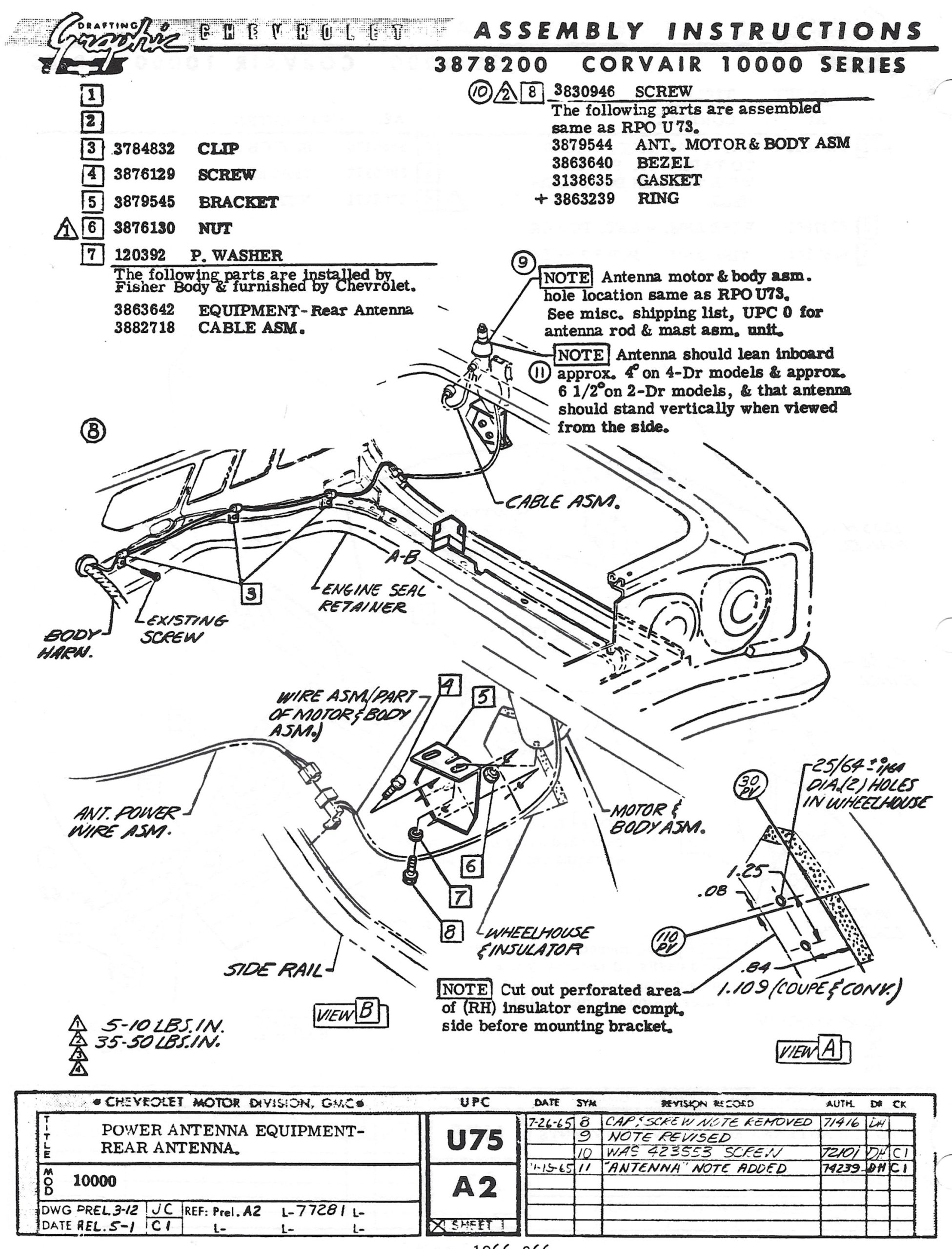
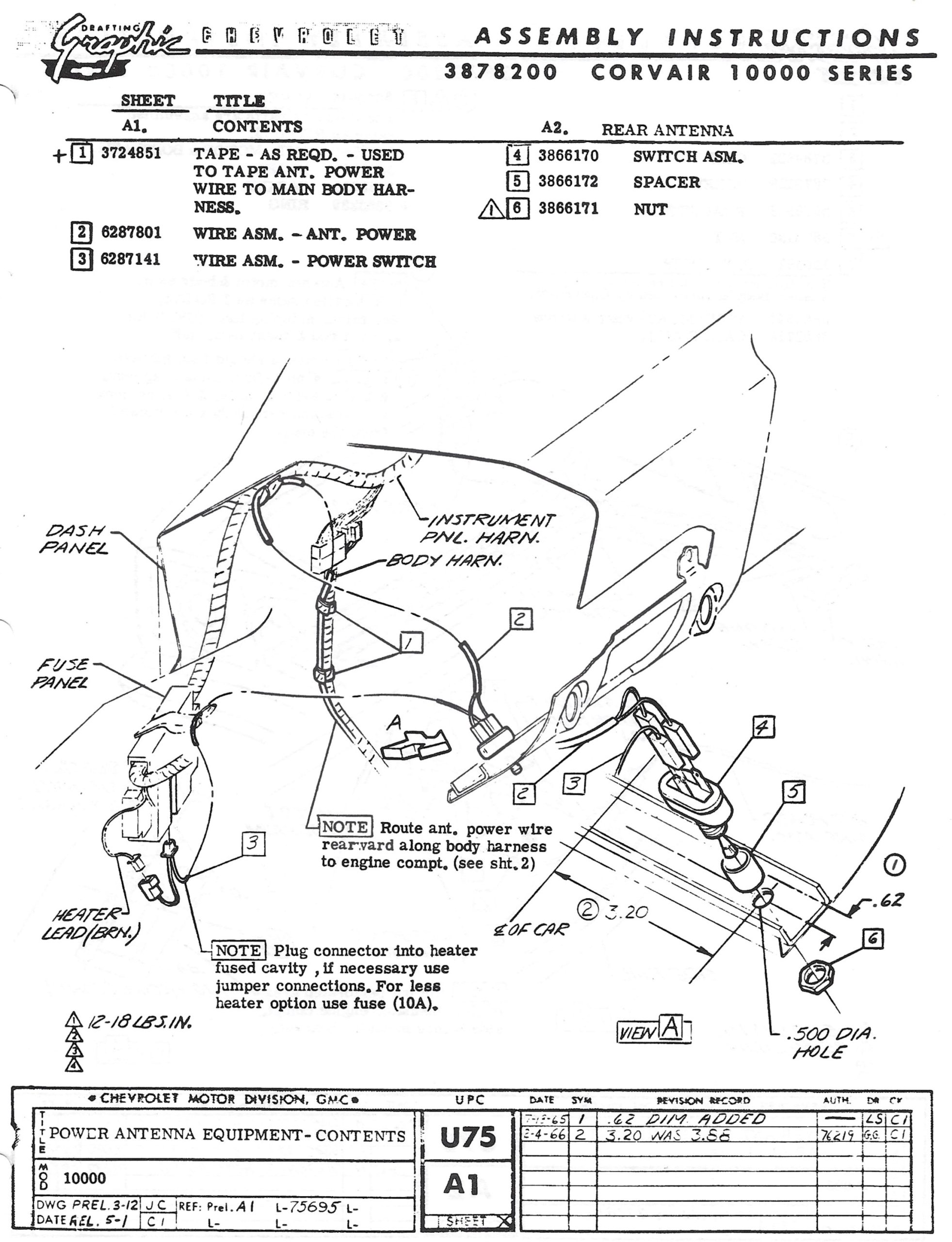
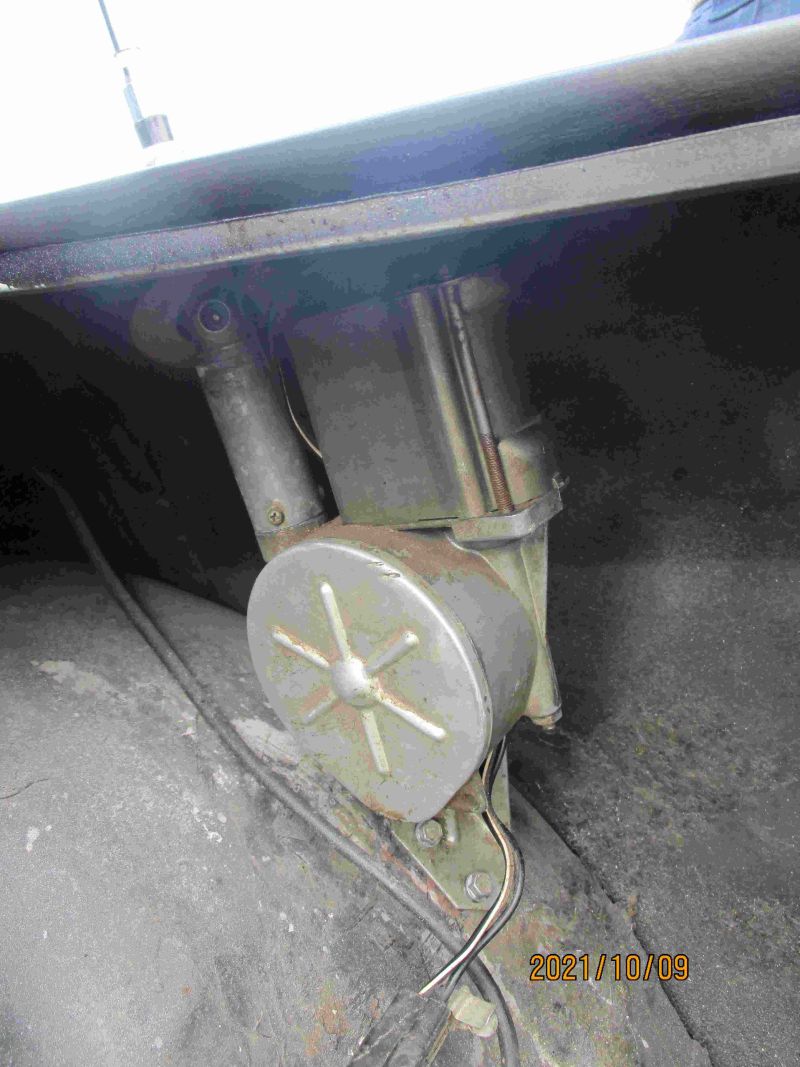
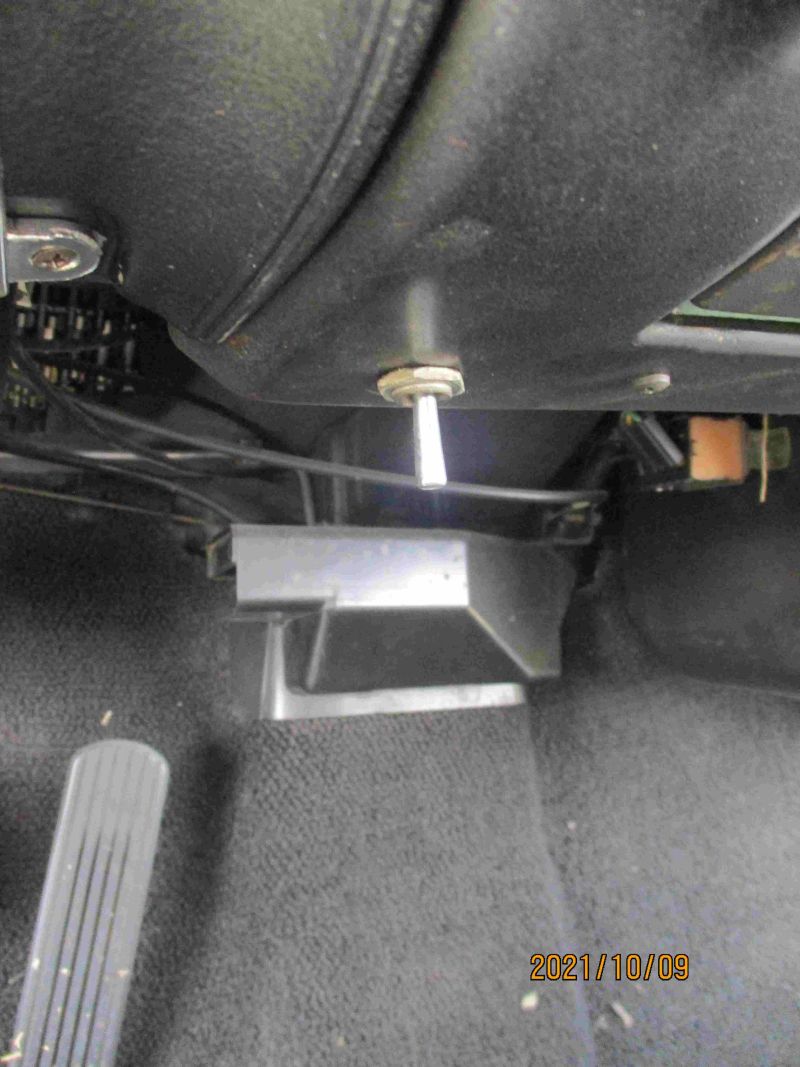
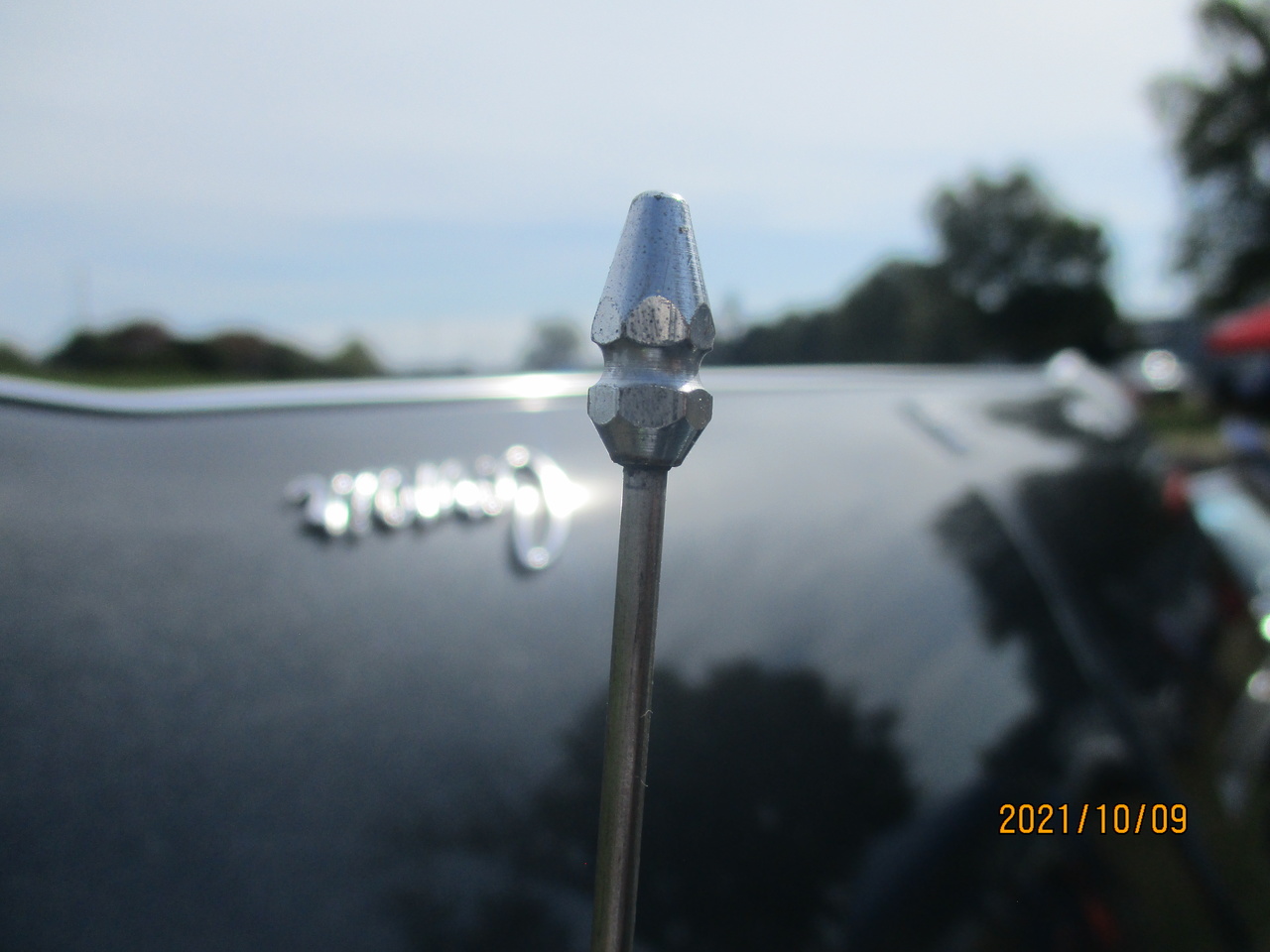
Antenna Photos
Cleaned up used antennas found at the Corvair Ranch:
L to R:
- 1960
- 1961-62 car
- 1961-62 FC
- 1963-64 car, front
- 1963-64 car, rear
- 1963-65 FC
- 1965 car front AM
- 1965 car rear AM
- 1967 car front AM
- 1967 car rear AM (wrong ground ring)
- 1966-68 car front FM
- 1969 front FM
- 1969 rear AM
Antenna Part Numbers
I’ve compiled this chart to summarize the part numbers for all of the antennas. The chart is mostly self-explanatory. The chart lists both MSL (option) and P&A (Accessory) part numbers for the complete antenna units.
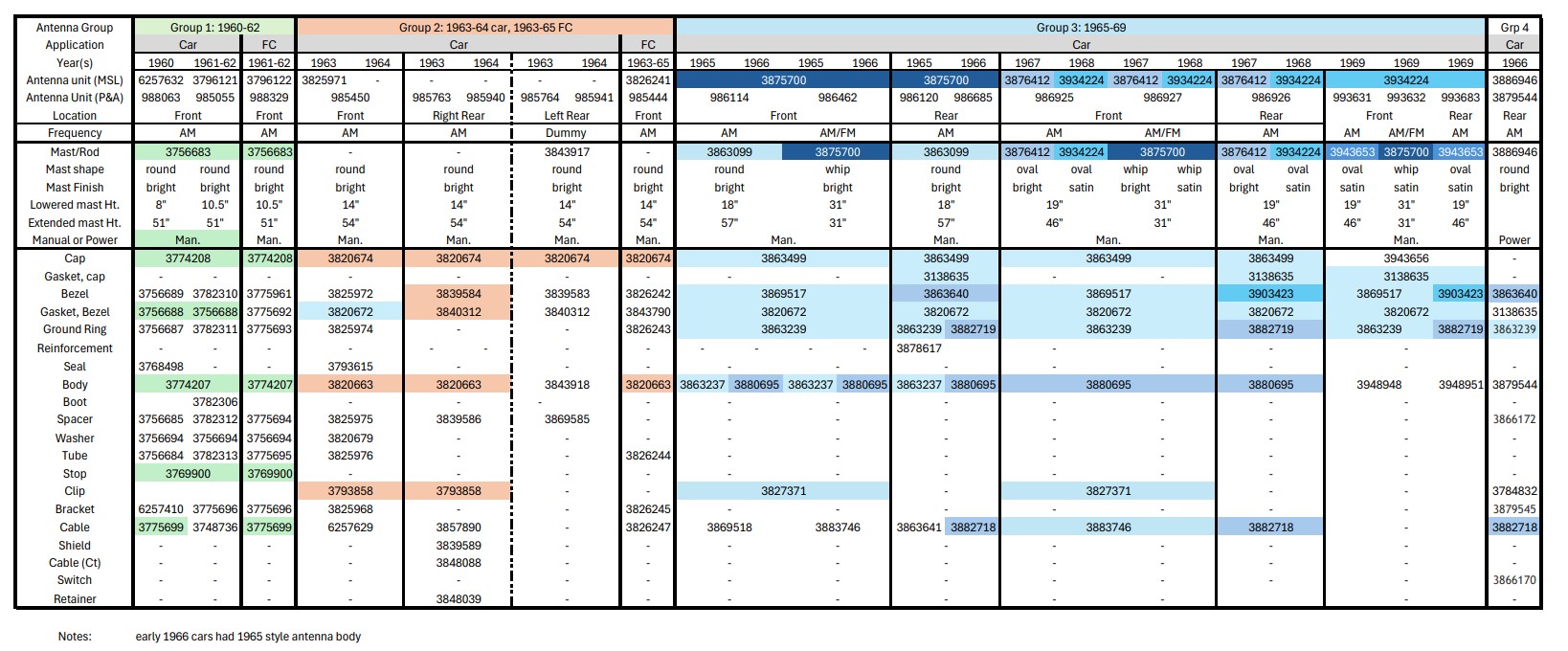
Sources and Credits
The information and photos contained in this article come from a variety of sources, including the following:
- 1960-69 Corvair car and 1961-65 Corvair FC Assembly Manuals (my personal collection).
- 1960-65 Chevrolet Accessory Installation Reference Manuals (scans supplied by Larry Claypool and Mark Corbin)
- Chevrolet Parts & Accessories (P&A) Catalogs (my collection)
- P&A 34 Corvair Parts Catalog, 1961
- P&A 34 Revision 3 Corvair-Chevy II-Chevelle, March 1, 1964
- P&A 5B Radio Parts Catalog, Revision #3, May 1, 1969
- Searches for “antennas” or similar keywords at Corvair specific sites, including the following:
- General Internet searches for “Corvair antenna parts” or for specific part numbers to find photos of NOS antenna parts.
- My own personal research of original Corvair antennas at the Corvair Ranch.
- Communication with other Stock Corvair Group researchers.
Special Thanks to Kent Sullivan and Larry Claypool for reviewing and editorial assistance.
Comments and feedback are welcomed!




